Table of Contents
Flags of Africa – National Flags
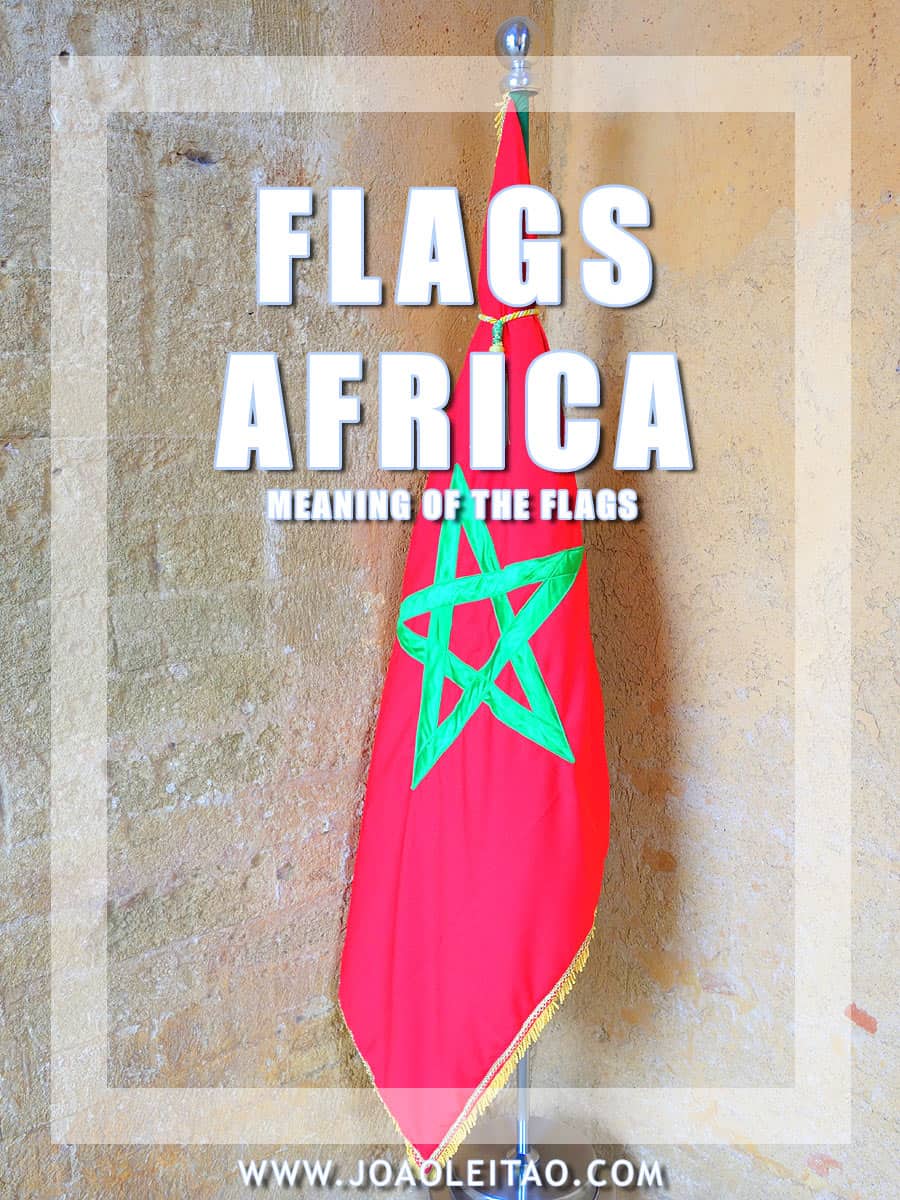
The flags represent the national identity of each country in Africa. Each flag color has a meaning in the history of each nation. African flags vary on color, shape, and meaning. On this page, I list all flags of Africa with their meaning and color explanation.
Copyright: I own the copyright usage of these images. You cannot use text or image without permission.
Africa National Flags
Flag of Algeria
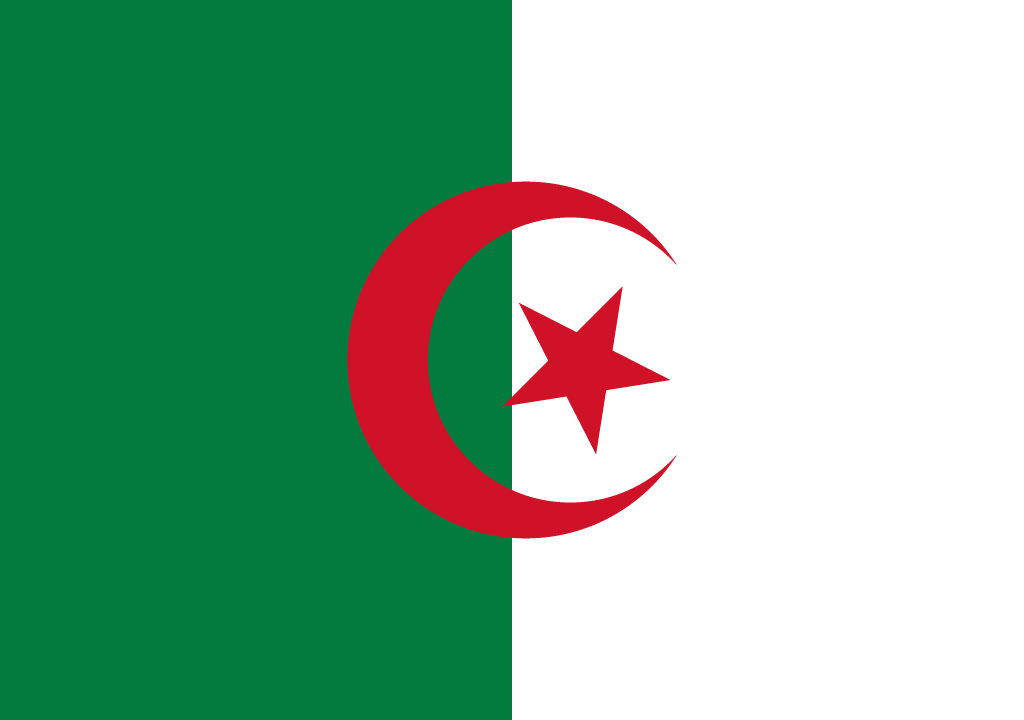
3 colors: white, green, red.
Meaning of the flag of Algeria: The red star and the crescent represent the religion, Islam. White symbolizes peace and honesty; green symbolizes the beauty of nature, hope, and joy; red symbolizes the blood of those killed fighting for independence in the Algerian War (1954 to 1962). The green on the Algerian flag also symbolizes the state religion of Islam.
History of the Flag of Algeria
The flag of Algeria is divided into two areas: green on the left and white on the right. In the center, there is a Crescent Moon around a five-point star, both in red. Green is a natural choice, for it’s the color of Islam, and white represents purity.
In the 19th-century, a white flag was already the symbol used by Abd al-Qadir, who was an Algerian turned national hero when he resisted the French. The red of the Crescent Moon and the star stand for the blood the Algerians shed while fighting against the European invaders.
This has been the national flag since the country’s independence in 1962 and was inspired by the flag of FLN (National Liberation Front), the movement that fought the French presence in Algeria and that still is the leading political party in the country.
Flag of Angola
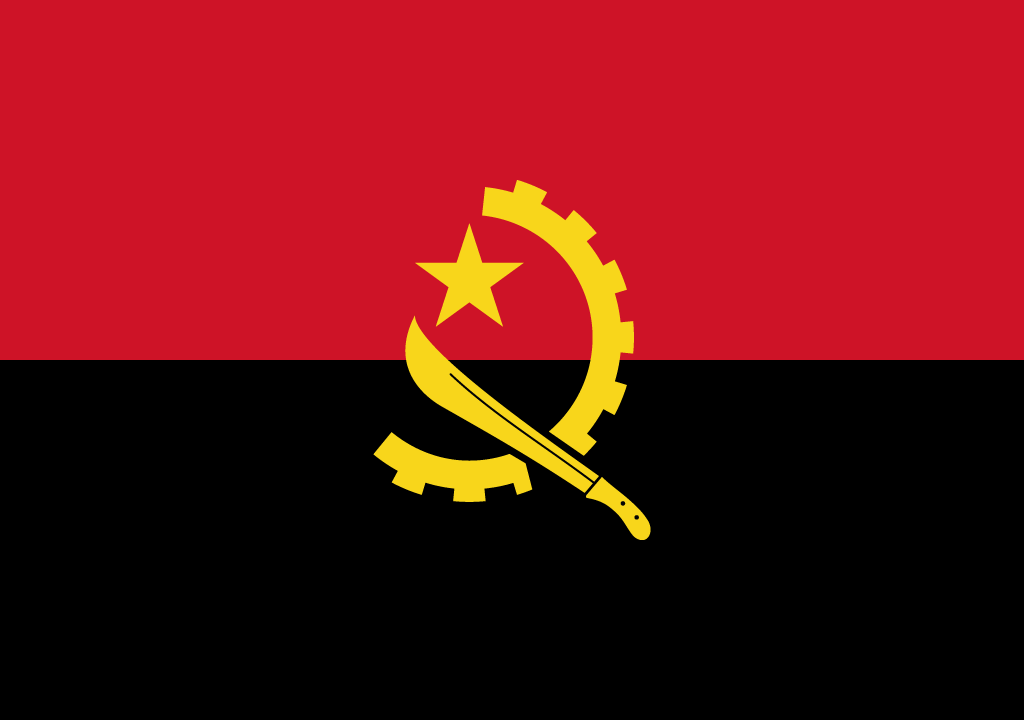
3 colors: red, black, yellow.
Meaning of the flag of Angola: One star represents international solidarity and development; machete represents the farmers, the agriculture process, and armed fight; cog wheel represents the workers and the industrial process. Red symbolizes the blood against the colonizers; black symbolizes the African continent; yellow symbolizes the natural resources.
History of the Flag of Angola
The flag of Angola was adopted in 1975, after the country’s independence. It’s split evenly into two horizontal areas: top red and bottom black. The first represents the blood shed during the war for independence, and the latter represents the African continent as a whole and the black people.
In the center, there are three yellow elements: a five-point star, slightly small, encircled by a part of a cog-wheel and a katana. Those are communist symbols that reflect the ideological influence of the main political party in Angola, MPLA, which in 1975 was affiliated with the Soviet Union. The star represents socialism, and the cog-wheel and the katana represent the national industry and agriculture. The yellow represents the country’s mineral wealth. In fact, the current flag is primarily influenced by the one of the political party, to which they only added the cog-wheel and the katana.
In 1996 and then in 2003 new flags were thought for Angola, but none of the projects came through.
Flag of Benin
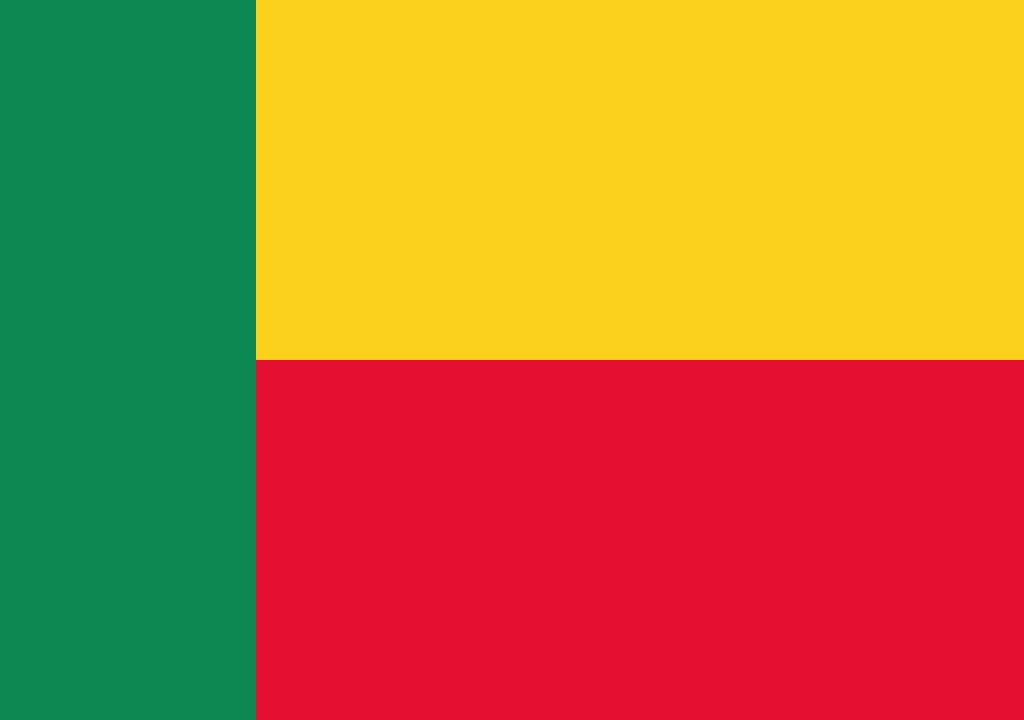
3 colors: yellow, red, green.
Meaning of the flag of Benin: Green symbolizes hope and the southern palm groves; red symbolizes the blood and courage of those who fought for Dahomey and yellow represents the natural resources and the northern savannas. All the colors represent the pan African spirit.
History of the Flag of Benin
As it happens with most African countries, Benin’s current flag was adopted when the country gained independence from France in 1960. The flag is divided into three different areas. The first vertical third of the flag is green. The other two thirds, both horizontal, are yellow (top) and red (bottom).
Why those colors? Because those are the colors of the Pan-African movement: the green stands for hope, the yellow stands for prosperity, and the red stands for the people’s bravery and the blood shed during the wars for liberation.
Between 1975 and 1990, the country had a Marxist-based government that changed the nation’s official name to the Republic of Dahomey. At that time, the flag was green with a red star in the top left corner.
Flag of Botswana
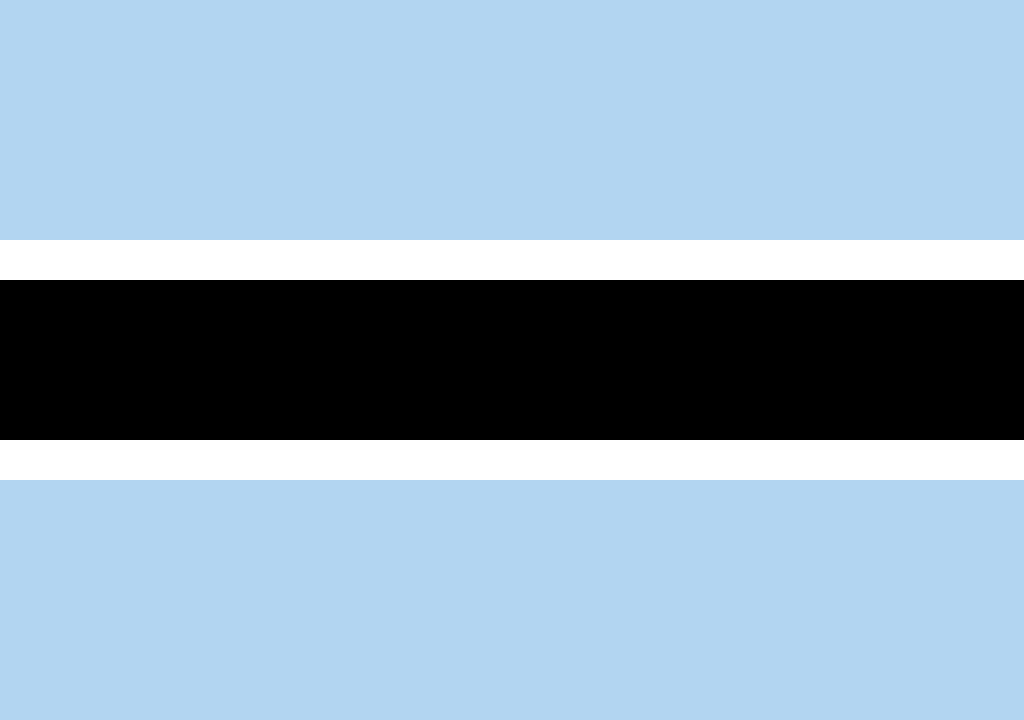
3 colors: blue, black, white.
Meaning of the flag of Botswana: Blue symbolizes water; white and black alternate stripes represent the ethnic harmony of the country and the liberal nature of society. The stripes symbolize the skin of the zebra, the national animal of Botswana.
History of the Flag of Botswana
The flag of Botswana was adopted after the country’s independence in 1966. The primary color is a very particular shade of blue, almost grayish. There’s a black stripe with a white border in the middle across the flag.
There isn’t specific information about the meaning of the flag and its colors. One of the theories links the blue to the need for rain, which people refers to as Setswana (let the rain come). The black and white could represent a zebra, Botswana’s national animal.
On the other hand, the three colors could represent the ethnic diversity of the country and the wish for peaceful coexistence.
Flag of Burkina Faso
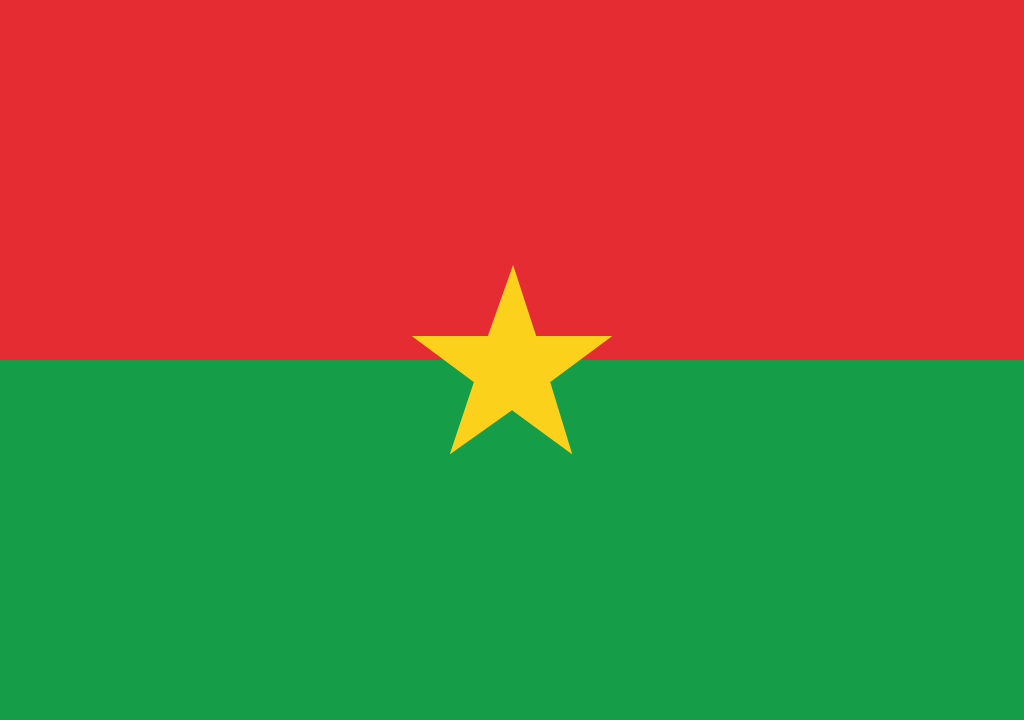
3 colors: red, green, yellow.
Meaning of the flag of Burkina Faso: Red represents the revolution; green represents the country’s profusion of natural resources. The yellow star symbolizes the guiding illumination of the revolt.
History of the Flag of Burkina Faso
The flag of Burkina Faso has two horizontal stripes, the top one is red, and the bottom one is green, and a five-point yellow star in the middle.
Although the colors are the same as the Pan-African movement, there is an official explanation that interprets the color choice differently. The red represents the socialist revolution and the green symbolizes Burkina Faso’s natural wealth. The colors also represent camaraderie among African countries. The star represents the guiding light of the socialist revolution.
This country was a French colony until 1960 and only adopted the current flag and the current name (it used to be called the Republic of Upper Volta) in 1984. Burkina Faso means “land of the upright men” in the local language.
Flag of Burundi
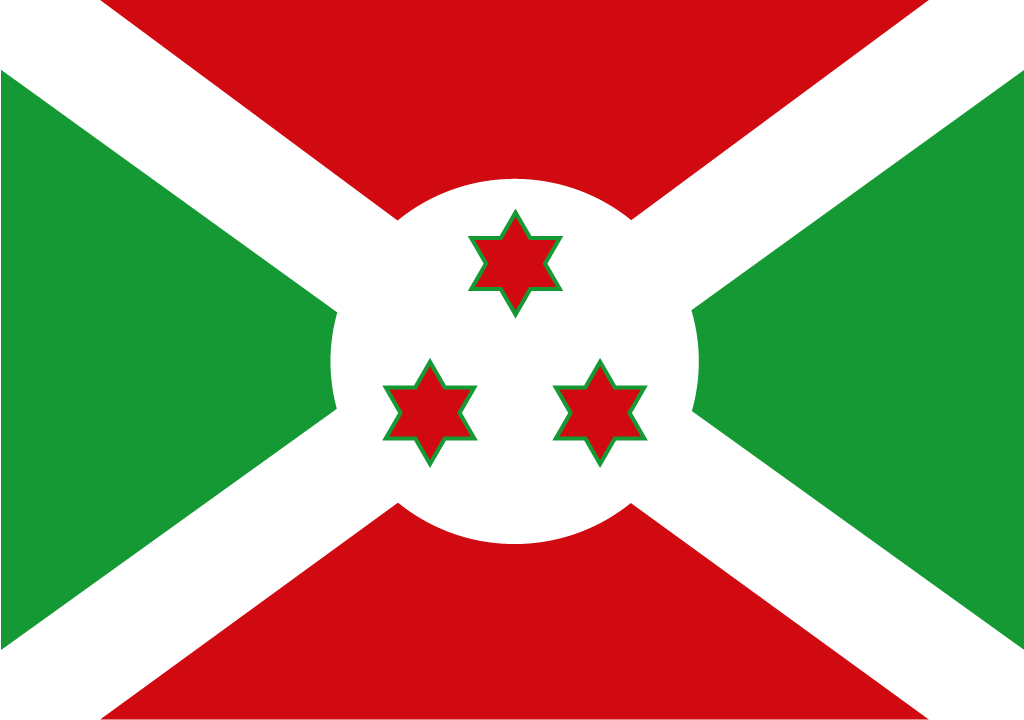
3 colors: red, green, white.
Meaning of the flag of Burundi: The stars in a triangular arrangement refer to the National motto of Burundi: “Unity, Work, and Progress”. The stars also symbolize the three ethnic groups in the country: the Hutu, Tutsi and the Twa. White represents peace, green stands for optimism and hope; red symbolizes the bloodshed of the soldiers in the struggle for independence.
History of the Flag of Burundi
The flag of Burundi is very distinguishing. In the center, a white circle overlays a horizontal X, also white, that crosses the whole of the flag. Inside the circle, there are three stars, red with green edges, laid in a triangle. The four segments created by the horizontal X are green (on the sides) and red (top and bottom).
The meaning of the stars in the center of the circle is not consensual. They could represent the three ethnicities living in Burundi (Hutu, Tutsi, and Twa), or the three words in the national motto: Unity, Work, and Progress.
The green means hope in the future and red symbolizes the blood shed during the fights for the country’s independence. As for the white, it represents peace.
Burundi became independent from Belgium in 1962 and adopted a flag similar to the current one. The only difference was the karyenda inside the circle, a drum with divine powers that broadcasted messages that only the king could receive. After the monarchy was abolished in 1966, the flag was changed and temporarily included the representation of sorghum, a plant that is essential for the country’s economy. The final and current version was adopted on 28 June 1967.
Flag of Cape Verde
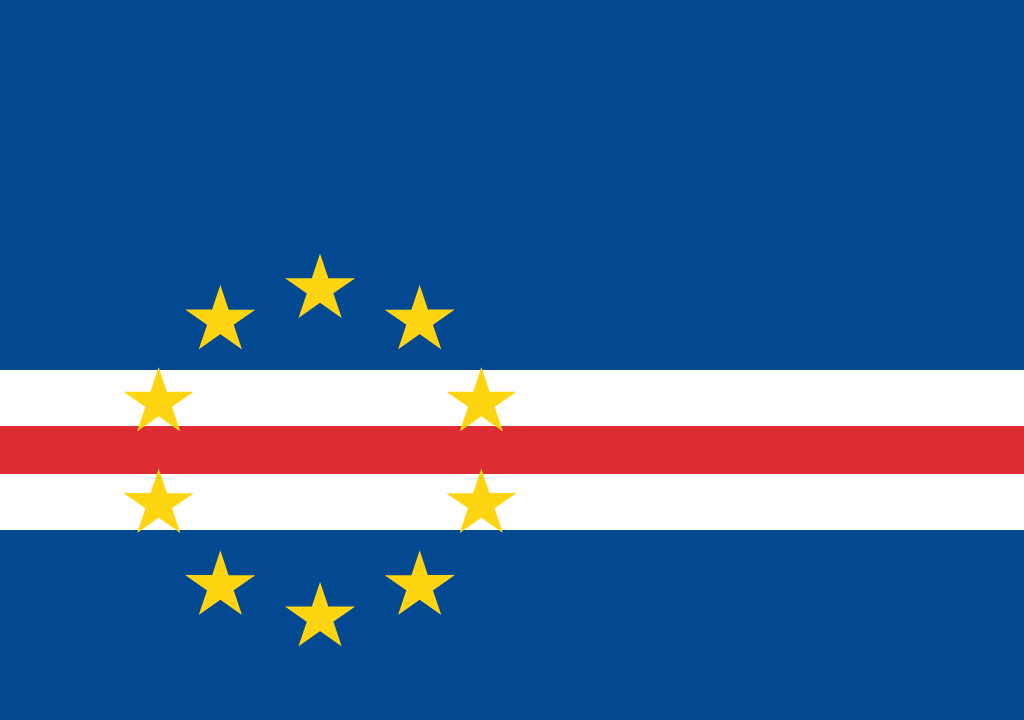
4 colors: blue, white, red, yellow.
Meaning of the flag of Cape Verde (Cabo Verde): Blue symbolizes the Atlantic Ocean; white represents peace. The ten golden stars represent the ten islands in this country. The red strip which passes through the white horizontal patch symbolizes economic progress.
History of the Flag of Cape Verde
The current flag in Cabo Verde was adopted on 22 September 1992, replacing the one that was chosen in 1975 when the country gained independence. That flag was green, red, and yellow, the colors of the Pan-African movement and of the PAIGC (African Party for the Independence of Guinea and Cape Verde), the main political party.
Cabo Verde’s current flag has a dark blue background and three horizontal stripes in the bottom half, one red in the middle and two white. There’s a circle with ten yellow five-point stars close to the bottom left of the flag that represent the ten islands of the Cape Verde archipelago.
The primary blue stands for the vast of the Atlantic Ocean around the islands. The stripes stand for the country’s growth towards building the nation, the white represents peace, and the red represents effort.
Flag of Cameroon
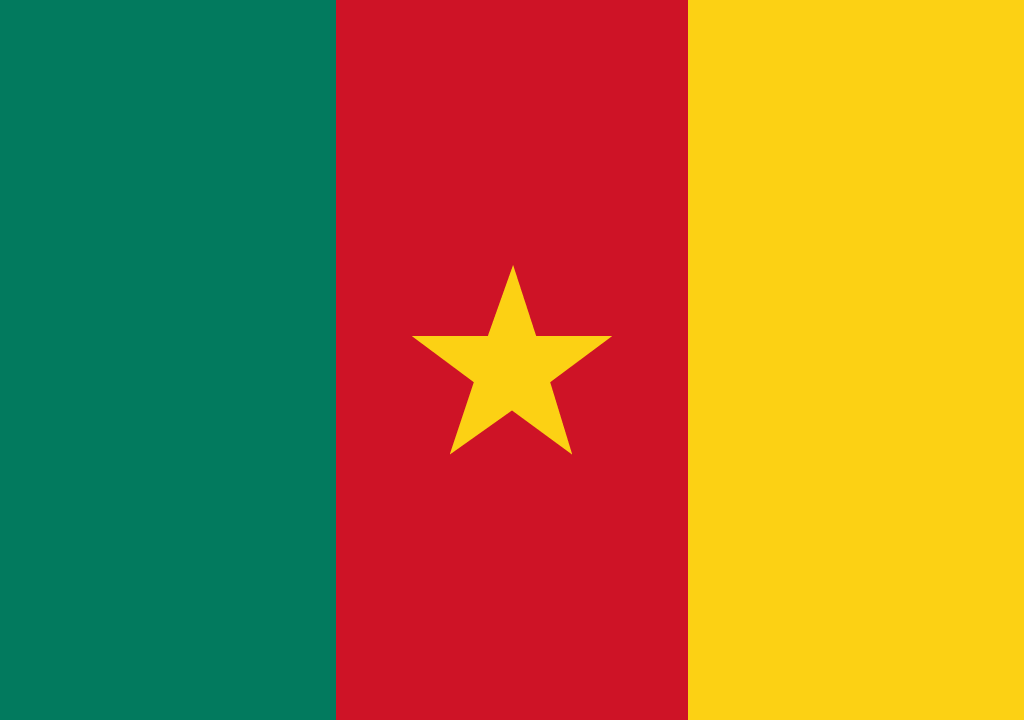
3 colors: green, red, yellow.
Meaning of the flag of Cameroon: Yellow represents happiness; green symbolizes hope; the red background of the star is a representation of unity and so is the “star of unity”. All the colors represent the pan African spirit.
History of the Flag of Cameroon
The three-color flag of Cameroon has three vertical stripes, from left to right, green, red, and yellow, and a yellow five-point star in the center.
Those are the colors of the Pan-African movement, and Cameroon was the second country to use them on their national flag. The green symbolizes the forests and the lush landscapes in the south, the yellow represents the sun and the vast savannahs in the north, and the red stands for unity. The star in the flag is also known as “the star of unity.”
After the country’s independence, the flag was slightly different. There were two stars instead of one, smaller and overlapping, in the top left corner (green side).
The current flag was adopted on 20 May 1975.
Flag of Central African Republic (CAR)
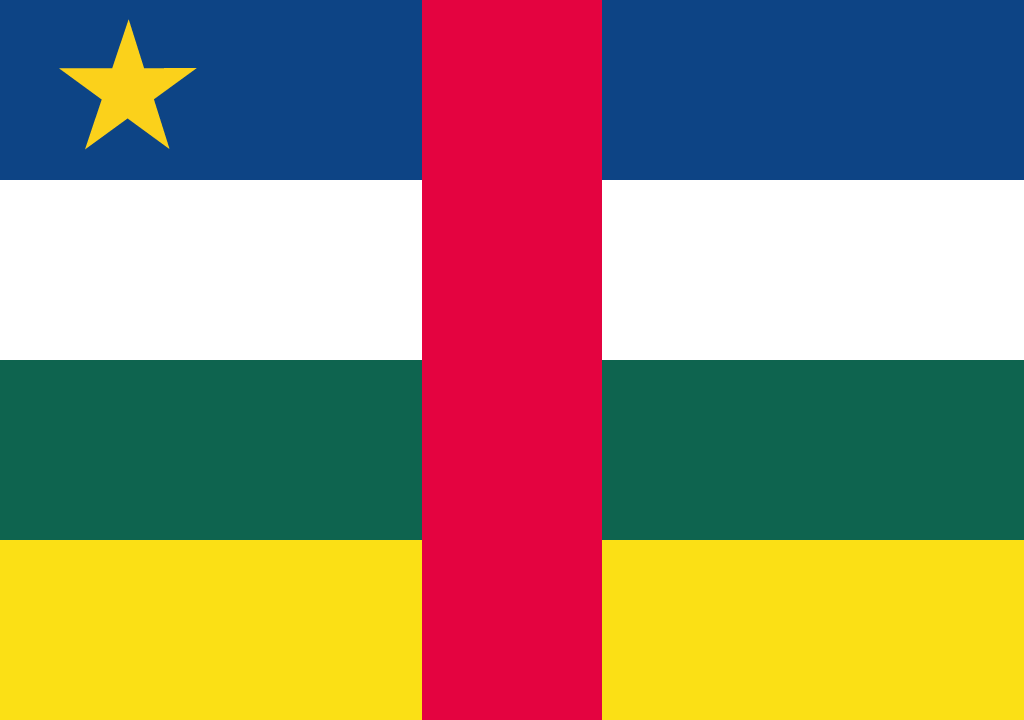
5 colors: blue, white, green, yellow, red.
Meaning of the flag of Central African Republic: The red in the vertical stripe represents the blood spilt by the people to achieve independence. In the horizontal stripes, blue symbolizes the sky and freedom; white stands for peace and dignity; green represents hope and faith; yellow represents the tolerance and hospitality of the people. The yellow five-point star of independence on the top blue stripe symbolizes a bright future.
History of the Flag of Central African Republic
The Central African Republic has one of the most colorful flags in the world. It has four horizontal stripes: dark blue, white, green, and yellow (top to bottom). There’s a red vertical stripe that crosses over the other four and a yellow five-point star in the top left corner.
The red, white, and blue stand for the country’s colonial past, while the red together with green and yellow are the colors of the Pan-African movement and stand for the union between the continent’s countries.
The vertical stripe also stands for the blood shed during the independence wars. The star is a common symbol in other African flags, and it stands for unity, progress, and tolerance.
The flag was adopted on 1 December 1958 and designed by Barthélemy Boganda, the president at the time. This is how he explained the flag to the Legislative Assembly:
“Those colors, which symbolize the four territories of the French Equatorial Africa but also our guide territory, the Metropolitan France. The red stripe which crosses the four colors is the symbol of our blood. As we did it when France was in danger, we shall shed our blood for Africa and to protect the Central African Republic, member of the French Community.”
In 1976, the country’s president Jean-Bédel Bokassa converted to Islam and tried to replace the flag but was quickly deposed. In December of that same year, a new Constitution confirmed the current flag as official.
Flag of Chad
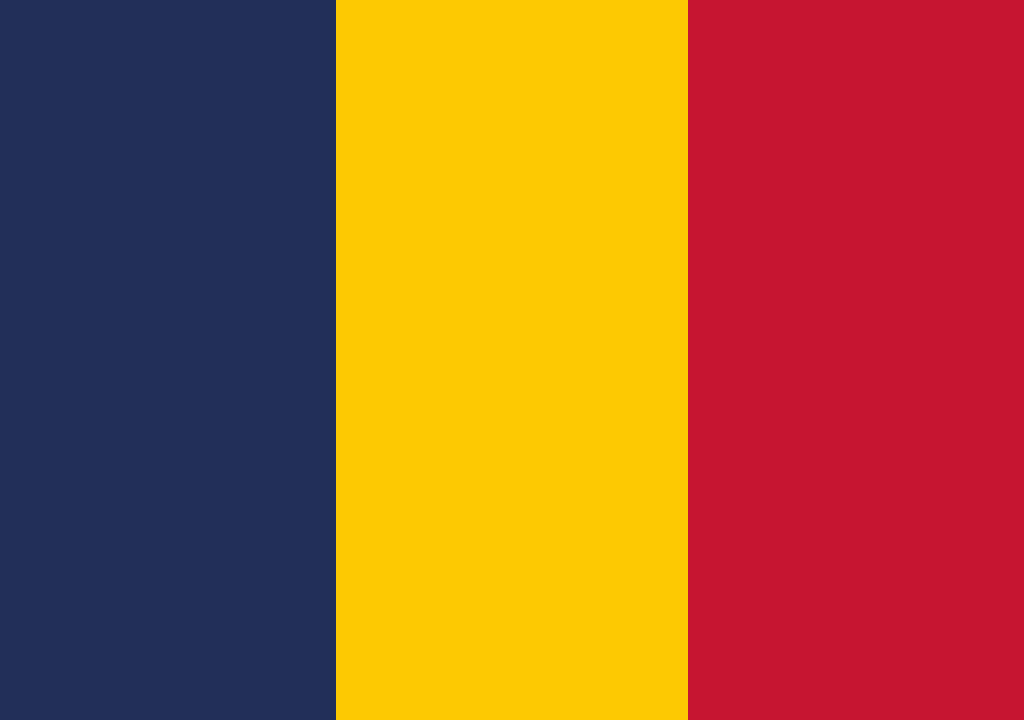
3 colors: blue, yellow, red.
Meaning of the flag of Chad: Blue represents the clear blue skies and the azure waters in the southern shores of Chad (hope and ambition); yellow represents the bright sunshine in Chad and also the sands of desert to the north of Chad; red symbolizes progress and unity and the sacrifice of the martyrs.
History of the Flag of Chad
The flag of Chad is simple, with three colors and three vertical stripes: dark blue, yellow, and red (from left to right). It’s very similar to the Romanian flag, except the blue is darker.
The design behind this flag was an attempt to combine the influence of the French flag with the colors of the Pan-African movement.
Its colors stand for the following: the blue represents sky and hope, the yellow represents the sun and the desert, and the red symbolizes the blood shed while fighting for independence.
The flag was adopted on 6 November 1959 and, despite all political troubles, it’s been unchanged for decades perhaps because there is no symbolic connection to any of the political forces that fight for power in Chad.
Flag of Comoros Islands
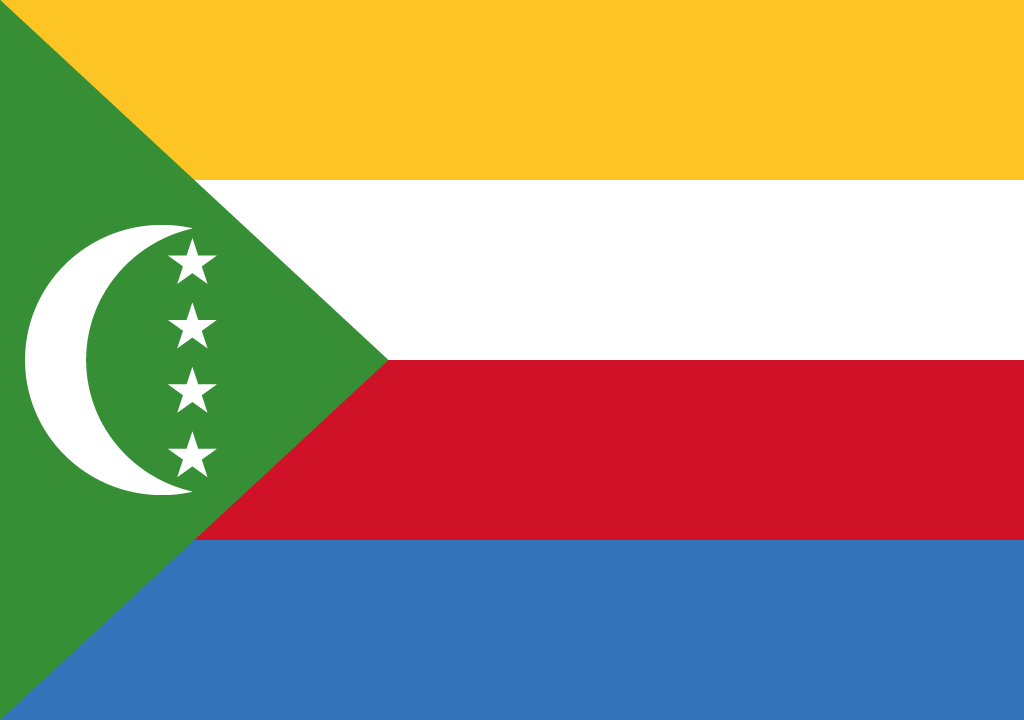
5 colors: yellow, white, red, blue, green.
Meaning of the flag of Comoros: The crescent, stars, and the green color represent Islam. Yellow, white, red, and blue all symbolize the four islands of the country: Moheli, Mayotte, Anjouan, Grand Comore. The four stars represent these islands too.
History of the Flag of Comoros Islands
The flag of this small African country, an archipelago between Madagascar and Mozambique, is quite colorful. It has four horizontal stripes: yellow, white, red, and blue (from top to bottom). On the left side, coming out of the flag’s edge is the base of a green triangle that stretches out almost until the middle. Inside that triangle, there’s a Crescent Moon and four five-point stars stacked vertically.
The current flag is the last version of many others used by the Comoros Islands. The first one is from 1963, right before independence. It was completely green, with the four stars diagonally laid over the Crescent Moon in the top left corner. Different versions followed, all placing the same elements in various configurations.
The current flag is the first one to include other colors besides green and red. It first appeared between 1976 and 1978 and was officially adopted on 7 January 2002.
The four stripes represent the four islands in the archipelago, including the one that’s not part of the country: yellow for Mohéli, white for Mayotte (under French administration), red for Anjouan, and blue for Grande Comore.
It has one white star for each island and the Crescent Moon represents the archipelago’s main religion Islam.
Flag of Democratic Republic of Congo
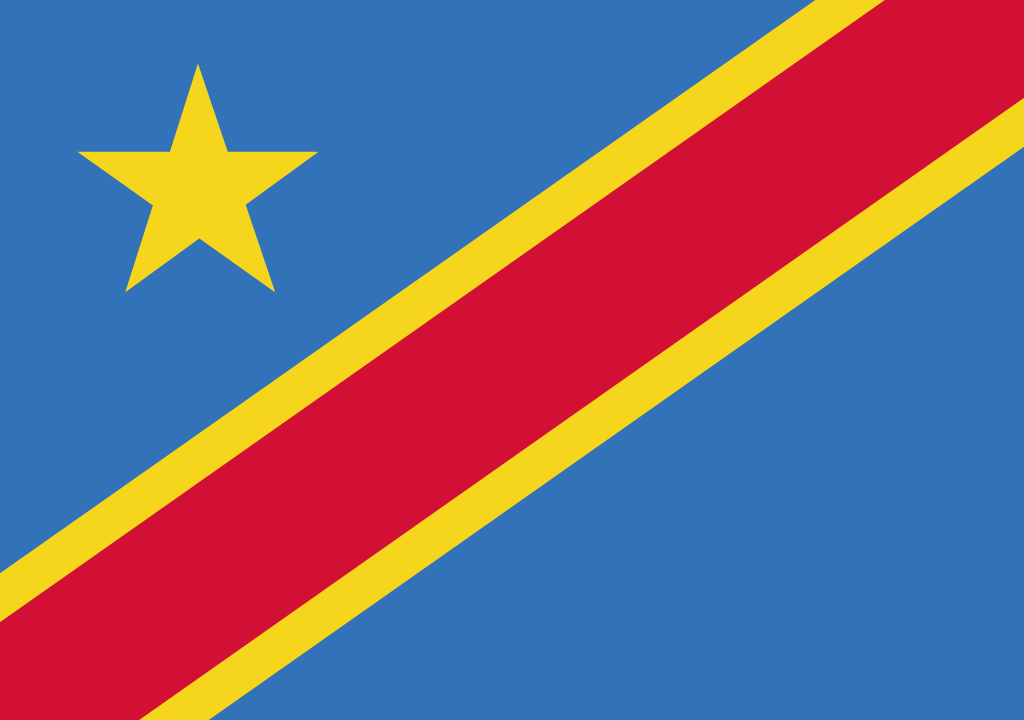
3 colors: blue, red, yellow.
Meaning of the flag of Democratic Republic of Congo: Red symbolizes the sacrifices of the national heroes; yellow stands for the country’s wealth; blue represents peace and harmony. The star symbolizes hope and ambition for the future.
History of the Flag of Democratic Republic of Congo
The flag of the Democratic Republic of the Congo has a bright blue background, a red and yellow diagonal stripe across, and a yellow five-point star in the top left corner.
The blue stands for peace, the red stands for the blood shed by patriots, and the yellow stands for prosperity. As for the star, it stands for the desire for a better future for the country. Although considering it’s similar to the one used by the Pan-African movement, the star might also represent the union between that continent’s countries.
When the Democratic Republic of the Congo became independent from Belgium in 1960, it was called Zaire and its first flag was based on the colors of Pan-Africanism, green, yellow, and red. However, the flag was changed after the 1996 revolution and the country adopted a blue flag with six stars and one more, larger, in the center.
The current flag was adopted on 20 February 2006.
Flag of Djibouti
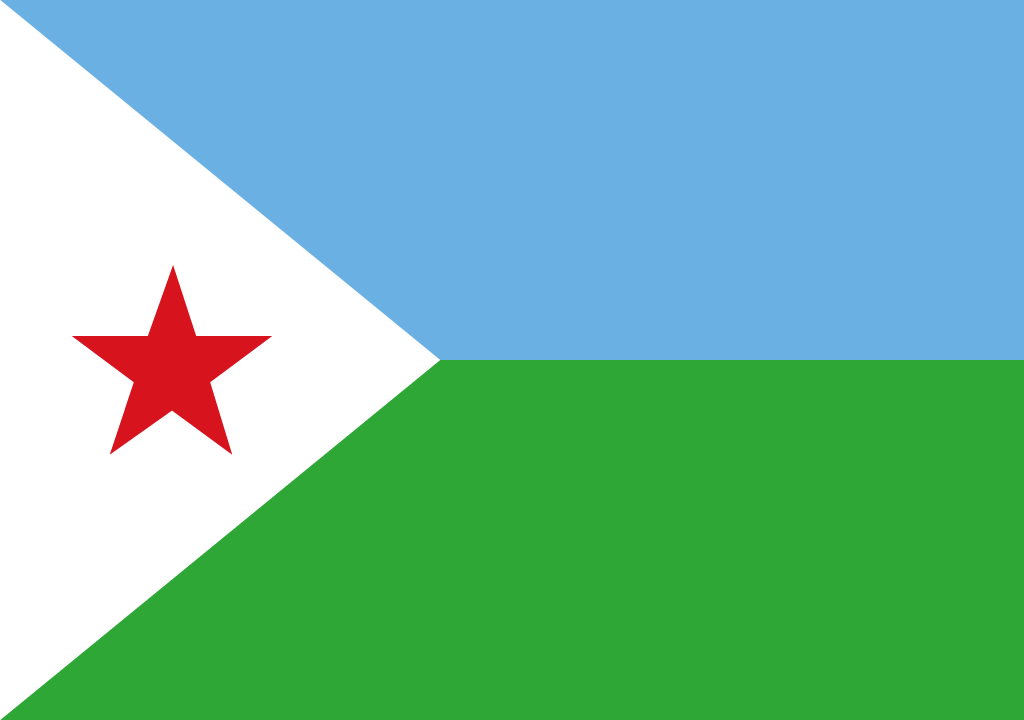
4 colors: blue, green, white, red.
Meaning of the flag of Djibouti: Blue represents the clear blue skies and the clear waters of Djibouti; green symbolizes the earth and the country’s landscape; white is the color of peace and represents harmony. The red star represents unity in the culturally diverse country and also the areas where the Somalis live.
History of the Flag of Djibouti
The flag of Djibouti has three areas: two horizontal stripes, light blue in the top and green in the bottom, and a white triangle on the left side with the base on the edge of the flag and the vertex pointing to the center. There’s a red five-point star laid over the triangle.
This flag was inspired by the one of the Independence National League that once ruled Djibouti in 1977.
The colors represent, in part, the tribes that live in the country: the Somali Issa frequently uses that blue shade and the Muslim Afar uses the green. On the other hand, the blue represents the sky, and the green represents the country’s landscapes.
The white stands for peace and the red star is inspired by the Pan-African symbol that represents unity.
The flag was hoisted for the first time on 29 June 1977.
Flag of Egypt
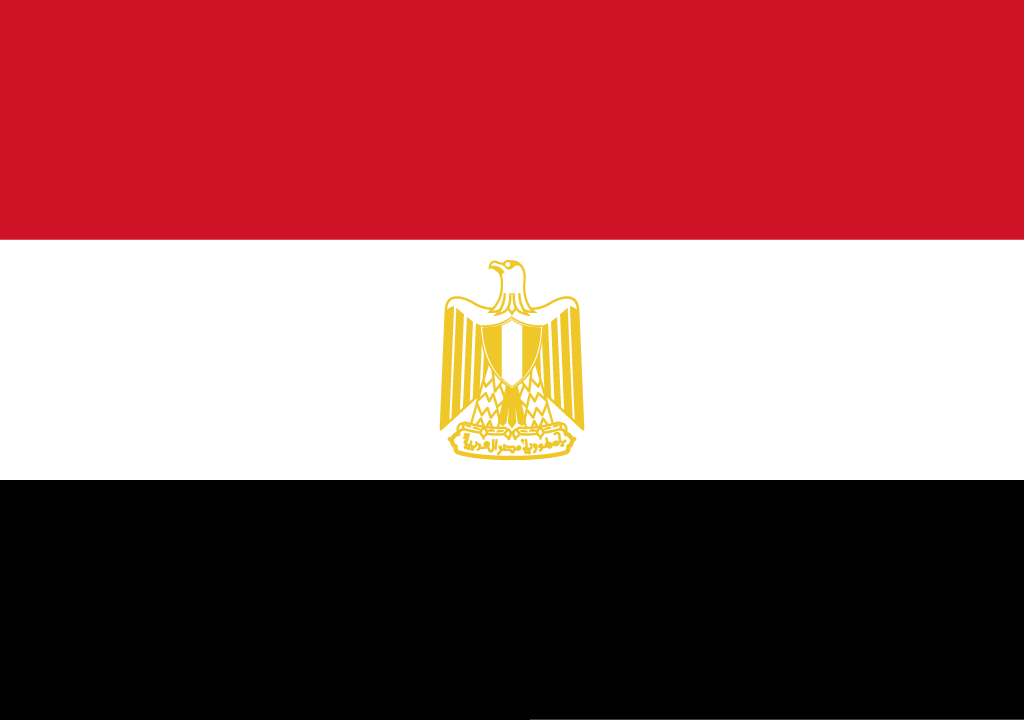
3 colors: red, white, black.
Meaning of the flag of Egypt: The Eagle of Saladin represents authority, beauty, and sovereignty. Red represents the period before the 1952 Revolution, marked by bloodshed and unrest; White symbolizes the bloodless revolution, which ended the monarchy and paved the way for Egypt’s transition into a republic; black symbolizes Egypt’s past, when the Egyptians were subjugated by the British, and the invincible spirit of the people.
History of the Flag of Egypt
The flag of Egypt has three colors in three horizontal stripes: red on top, white in the middle, and black on the bottom. In the middle of the flag, centered, there’s the symbol of the eagle of Saladin.
White means the purity of feelings of the Egyptian people, black, on the bottom, symbolizes victory over darkness, and red means the blood that was shed at war in Egypt. The eagle was adopted as a national symbol of Egypt a long time ago, to honor Saladin’s role in ousting the Crusaders from the region.
This flag has influenced a few other ones later created in countries like Syria, Sudan, Iraq, Yemen, and, for some time, Libya.
Although Egypt was only officially independent from the United Kingdom in 1922, there used to be a national flag before that, similar to the current flag of Turkey: all red with a white Crescent Moon and a star. After 1922, the country adopted a flag with a Crescent Moon and three stars over a green background. Those three stars symbolized the three main territories of the country: Egypt, Sudan, and Nubia. Some people claim the stars symbolized the country’s three main religious groups: Christians, Muslims, and Jewish.
The military coup of 1953 ended the monarchy regime and the new government created the one we currently know as the Egyptian flag, although it kept the same previous flag. In 1958, that revolutionary flag was adopted as the national flag, but instead of the eagle of Saladin, it had two green stars in the center. At that time there was a brief union between Egypt and Syria, and that is the same flag used in Syria now. In 1972, the country adopted the final version of the flag, the one we know today.
Flag of Equatorial Guinea
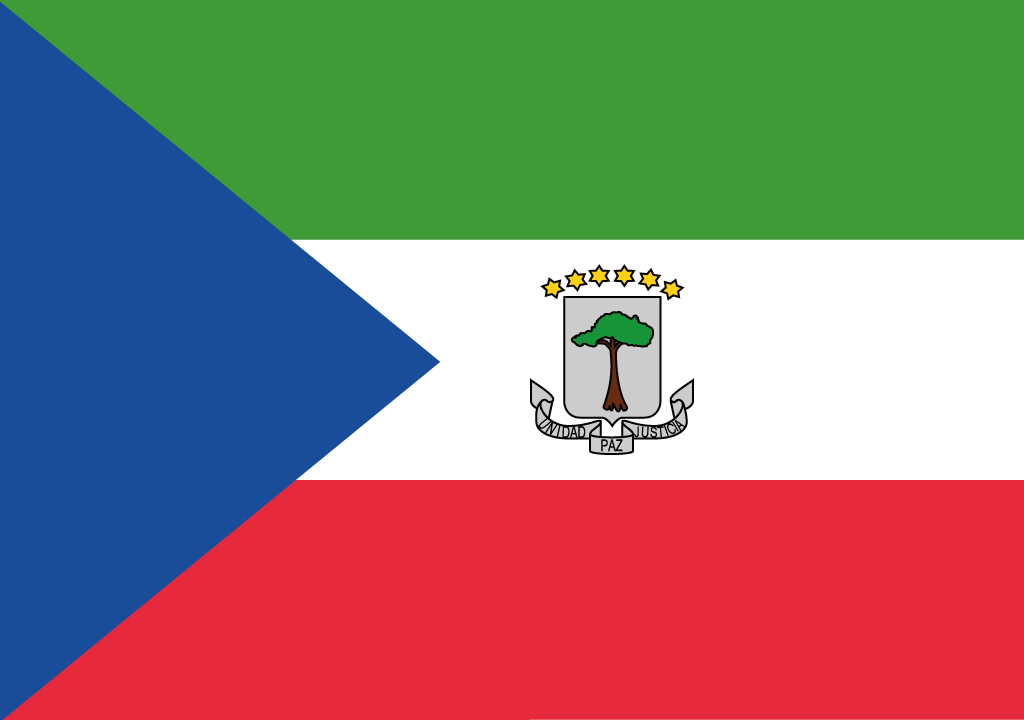
4 colors: green, white, red, blue.
Meaning of the flag of Equatorial Guinea: Green symbolizes the luxuriant vegetation and the fertility of crops; white stands for peace and harmony in which the country lives; red represents the blood spilt by the patriotic fighters for independence; blue symbolizes the clear pure waters of the infinite sea which connects Equatorial Guinea’s islands. The national coat of arms in the white stripe is a shield with a silk cotton tree, “God’s tree,”, representing the historical link between Equatorial Guinea and Spain. The tree has six yellow stars over it, which represent the mainland and the five main islands of the nation: Annobon, Bioko, Corisco, Great Elobey and Small Elobey. Under the shield containing the tree, we can read the words “Unidad, Paz Justicia” – “Unity Peace Justice”.
History of the Flag of Equatorial Guinea
The flag of Equatorial Guinea has three horizontal stripes, one top green, one middle white, and one bottom red. On the left side, the base of a triangle that stretches toward the center, but without reaching the middle of the flag as it happens with other flags using the same design.
In the center of the flag, over the white stripe, there’s the national symbol: a common tree in the country with five golden five-point stars on top laid in a semi-circle. Underneath, the motto “Unidad, Paz, Justicia” (Equatorial Guinea is the only country in Africa with Spanish for an official language).
The stars represent the national territory: four islands and the mainland. The blue (in the triangle) symbolizes the Atlantic Ocean, green symbolizes the primary color of Equatorial Guinea’s landscapes, white symbolizes peace, and red symbolizes the blood that was shed during the independence war.
This flag was first adopted on Independence Day, 12 October 1968, but when Francisco Nguema was president (1973-1979) the national symbol was different. Therefore, the current flag was adopted on 21 August 1979.
Flag of Eritrea
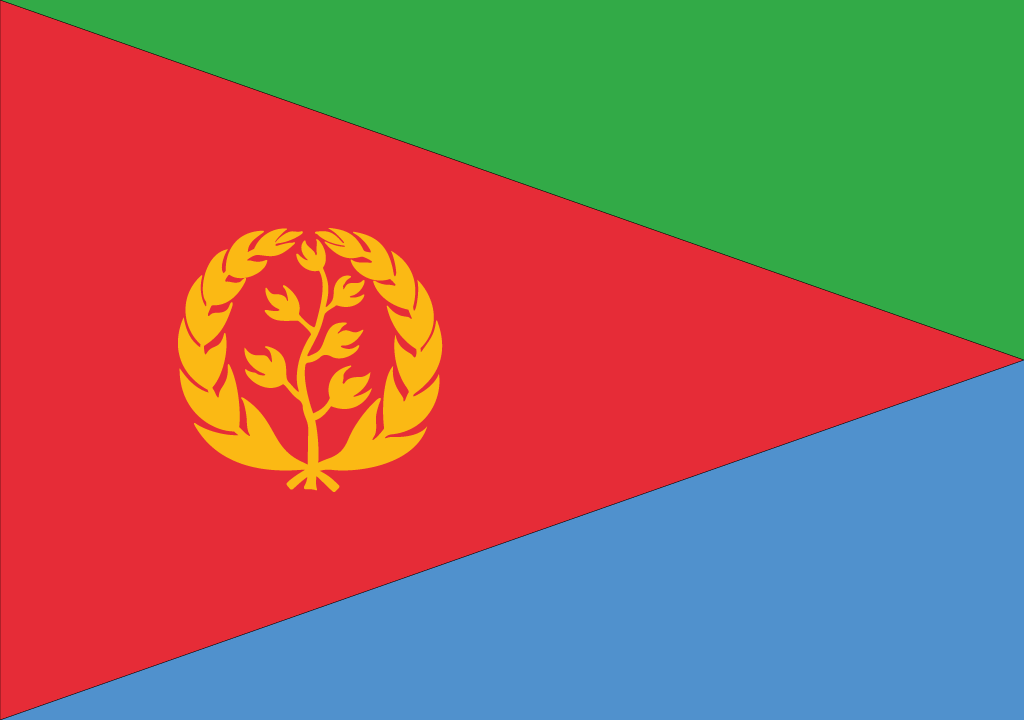
4 colors: green, red, blue, yellow.
Meaning of the flag of Eritrea: The olive branch symbolizes peace and has been borrowed from the flag of the United Nations. Green represents the country’s natural beauty, lush greenery, and fertility; blue symbolizes the vast oceans and seas, particularly the Red Sea; red represents the noble patriotic spirit displayed by the martyrs during the fight for independence; yellow symbolizes the abundance of minerals in Eritrea.
History of the Flag of Eritrea
The flag of Eritrea has three distinct areas. They’re basically three triangles: one with the base covering all the left side and with the vertex stretching towards the center of the opposite side. This one is red and shaped kind of like the country. The other two triangles, both of them orthogonal, have their bases on each half of the right side of the flag: green on top and blue in the bottom.
On the left side of the flag, over the red triangle, there’s a symbol with an olive branch encircled by a wreath made with leaves of the same tree. This symbol was inspired by the former flag of Eritrea, that had these symbols to honor the United Nations.
The red symbolizes the blood that was shed for the country’s independence, the blue symbolizes the ocean, and there’s also a connection to the UN flag, and green symbolizes the fields of Eritrea.
Eritrea became independent, with the help and support of the United Nations, in 1952. But the country’s autonomy ended ten years later after a civil war, when Ethiopia annexed Eritrea, ironically with the help of the United Nations.
Eritrea regained independence in 1993 and has been using the current flag ever since, with a slight variation in proportion. The new flag was hoisted for the first time on 24 May 1993.
Flag of Ethiopia
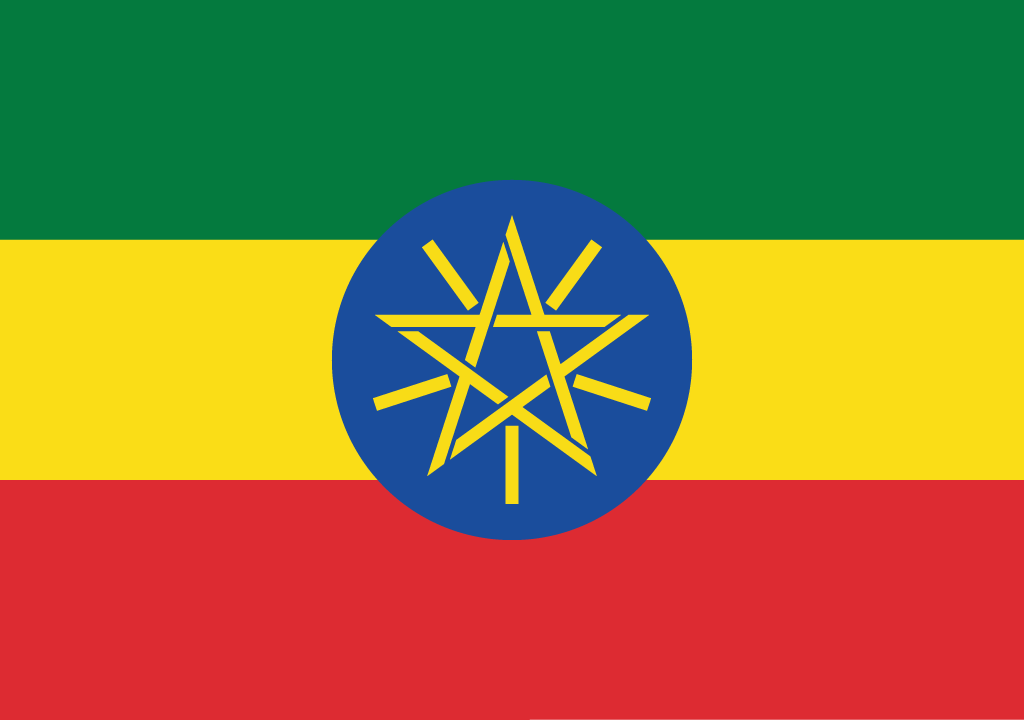
4 colors: green, yellow, red, blue.
Meaning of the flag of Ethiopia: Green represents hope and fertility of the land; yellow symbolizes harmony for Ethiopian people; red symbolizes valor and war in the struggle for independence and resistance to colonist takeover. The yellow five-pointed star symbolizes the future of the country and possibly also King Solomon and the Star of David. The five yellow rays around the star represent equality of the various people in Ethiopia.
History of the Flag of Ethiopia
The flag of Ethiopia includes the distinctive colors of Pan-Africanism: green, yellow, and red, from top to bottom. The national symbol, in the center over the yellow stripe, is a yellow pentagram with five sunbeams over a blue circle. The emblem represents equality between all Ethiopians but also their diversity. The blue is linked to peace, and the beams are connected to prosperity.
Regarding the color scheme, it not only relates to Pan-Africanism, but Ethiopia was the inspiration for the movement to adopt those colors. However, the reason why the colors green, yellow, and red were chosen to become the national colors of Ethiopia was never determined. Some say the rainbow was a source of inspiration because it’s such a frequent phenomenon at the Blue Nile waterfalls.
In the flag, green can symbolize the lands of Ethiopia, yellow symbolizes peace, and red symbolizes strength.
The same colors were already present in older flags before this official one. King Melik II ordered, on 6 October 1897, the creation of a national flag, with the same horizontal stripes, except the red was on top. Since then, that national symbol has been through several periods of change: under Emperor Haile Selassie, after his death, during the Derg regime, during the transition period, and finally on 31 October 1996 (when the current flag was adopted).
Flag of Gabon
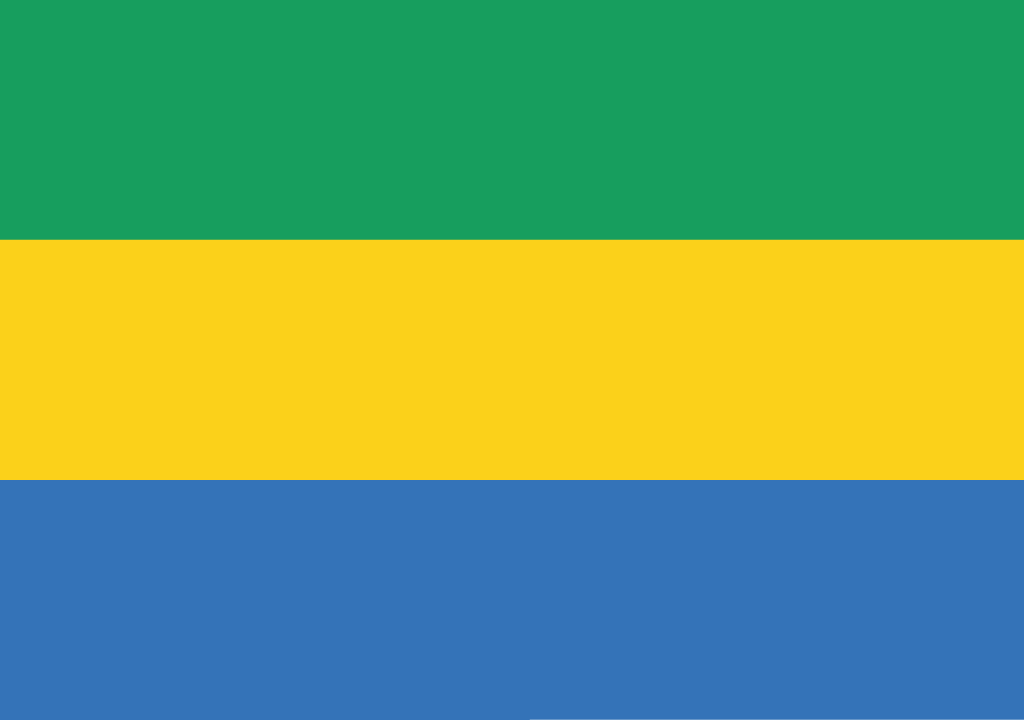
3 colors: green, yellow, blue.
Meaning of the flag of Gabon: Green represents the natural resources of the forests; yellow symbolizes the equator, which passes through the country, as well as the minerals found in Gabon (mainly gold), and the bright and warm sunshine; blue stands for the crystal clear waters of the Atlantic shore.
History of the Flag of Gabon
The flag of Gabon has three colors in three horizontal stripes: green on top, yellow in the middle, and blue in the bottom.
Gabon became independent from France in 1960 and has kept true to the flag adopted at that time, which includes the green and yellow of the Pan-African movement. A movement that was inspired by the colors of the Ethiopian flag. The blue, even though it’s in a different shade from the one used in the French flag, is believed to be a reference to the colonial past.
The green symbolizes the Gabon forests and the wood industry, yellow symbolizes the sun and the country’s location at zero latitude, and the blue symbolizes the Atlantic Ocean and the national rivers, especially Ogowe River.
Although the national flag has been unchanged since it was adopted on 9 August 1960, it’s based on an older model created one year earlier. It included the same colors but also a small French flag in the top left corner, just like it happens with the flag of Australia and other countries with the Union Jack.
Flag of Gambia
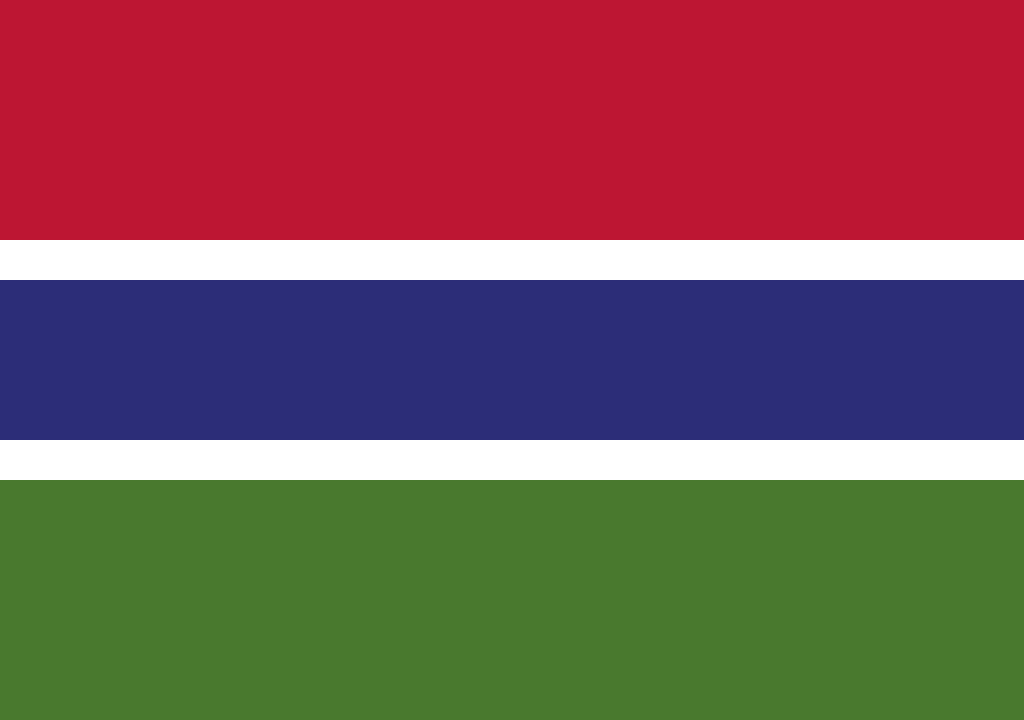
4 colors: red, blue, green, white.
Meaning of the flag of Gambia: Red represents the savanna grasslands and also the sun; blue symbolizes the waters of the Gambia River; green represents the wild plants, agriculture and the forests of Gambia. The two white stripes represent peace, unity and harmony.
History of the Flag of Gambia
The flag of the Gambia has three horizontal stripes with two thinner white lines separating them. On the top, a red stripe that symbolizes the intense sunshine in the country’s savannahs. In the middle, a narrower blue stripe that represents the Gambia River, a geographical trait that was crucial to building this country since it basically grew alongside the river’s course. The green in the bottom symbolizes the national fields and lush green vegetation of the Gambia. The white, in the thin lines, symbolizes union and peace.
The current flag was adopted on 18 February 1965 when the country became independent from the United Kingdom. It’s been unchanged ever since, despite the different political changes that included a seven-year union with Senegal (1982-1989). When the Gambia became independent, there was a national public competition to choose the flag for the new country. Louis Thomasi, an accountant, was the winner and the creator of the flag.
Flag of Ghana
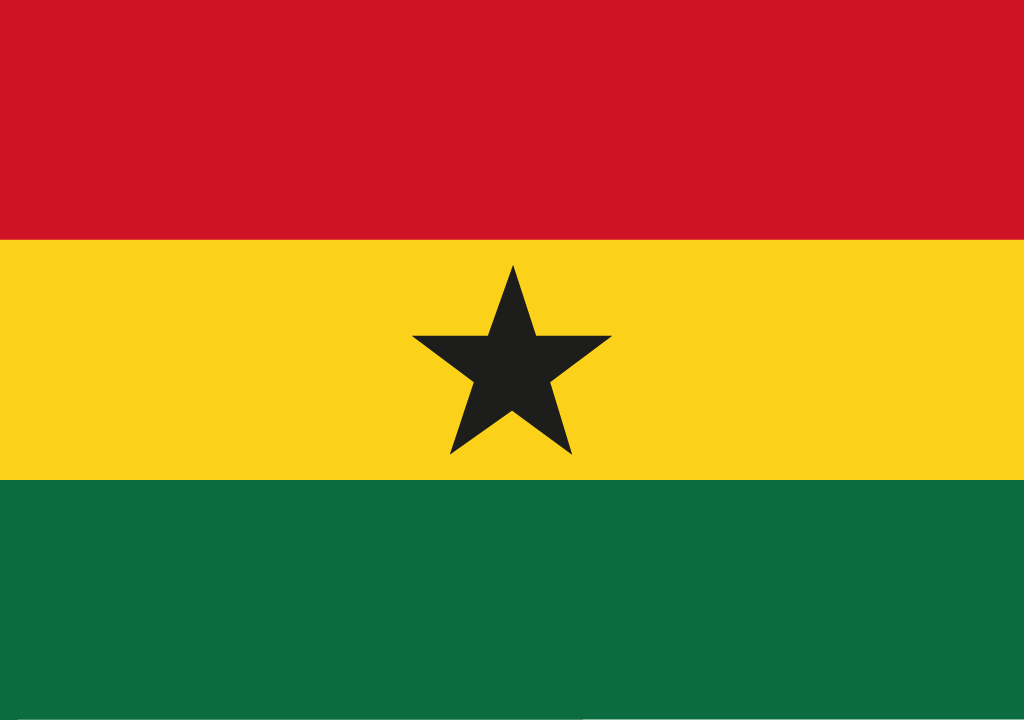
4 colors: red, yellow, green, black.
Meaning of the flag of Ghana: Red symbolizes the revolutionary spirit and the sacrifices of the country’s martyrs fighting for independence; yellow represents the abundance of minerals in Ghana; green symbolizes the natural resources like the forests in the country. The black star with five points represents the emancipation of Ghana and the unity and patriotic spirit of the people who fought colonialism.
History of the Flag of Ghana
Ghana became independent from the United Kingdom on 6 March 1957 and immediately adopted the current flag, although it was changed countless times until it went back to the original template. Ghana was the first country to use the three colors of the Pan-African movement in its flag.
The flag’s three horizontal stripes are, top to bottom, red, yellow, and green. There’s a black five-point star in the center, over the yellow stripe.
The flag was designed by Theodosia Okoh and chosen by the first president of the country, Kwame Nkrumah.
The designer said: “I decided to use these three colors, red, yellow, and green, because of Ghana’s geography. Ghana is a tropical country blessed with rich vegetation. The yellow is inspired in our land’s mineral richness and the red honors all of those who worked and died for the country’s independence. As for the five-point star, it’s a symbol of African emancipation and fight against colonialism.”
Between 1958 and 1961, the flag was changed to include two black stars, a symbol of the short-lived political union with Guinea. After Mali joined this union, between 1961 and 1964, a third star was added. Between 1964 and 1966, yellow was replaced with white, but on 28 February 1966 Ghana returned to the original flag.
Flag of Guinea
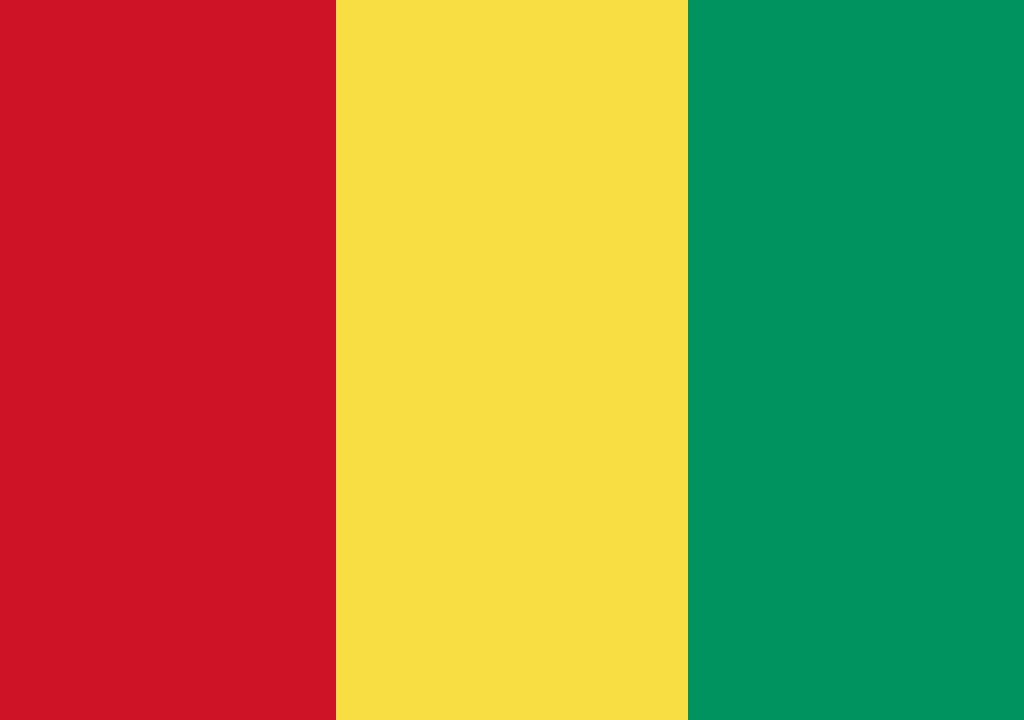
3 colors: red, yellow, green.
Meaning of the flag of Guinea: Red represents the blood of the martyrs in the fight for independence and the work of all workers in the country; yellow symbolizes the riches of mineral resources, especially gold, and the sun that shines in Guinea; green represents the natural resources of the country, as well as prosperity and the fertile land of the country.
History of the Flag of Guinea
Guinea became independent from France in 1958 and immediately adopted the same flag that’s in use today.
Maybe inspired by the French flag, they chose a three-color flag with vertical stripes, from left to right, red, yellow, and green. Those are the colors of the Pan-African movement, the colors that Ghana had used in its national flag one year earlier.
This flag is similar to the former flag of Rwanda that, because of the similarities, used the letter R in the center.
In addition to the universal symbolism of the colors, that represent the union between all African people, president Sékou Touré said this was the meaning of the flag’s colors: red symbolizes the blood that was shed in the fight for independence, yellow symbolizes the sun and the richness of Guinea’s subsoil, and green symbolizes the lush vegetation in the country.
The flag was officially adopted on 10 November 1958.
Flag of Guinea-Bissau
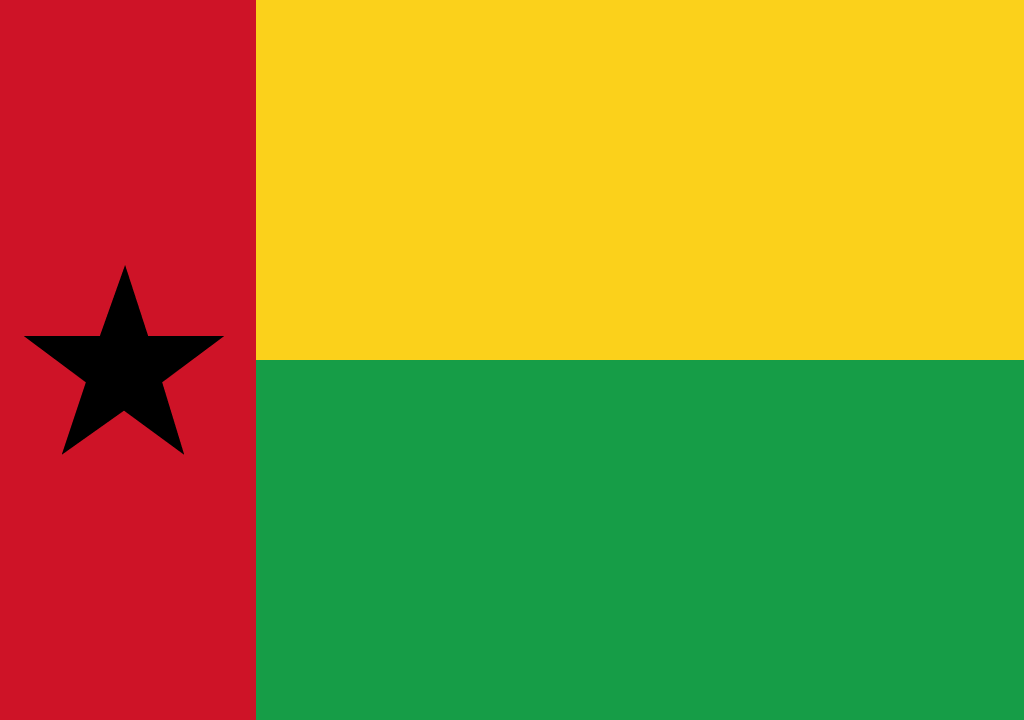
4 colors: yellow, red, green, black.
Meaning of the flag of Guinea-Bissau: Red represents the blood spilt by the people who fought for independence from Portugal; yellow symbolizes the abundance of minerals in the country the bright sunshine heating up Guinea-Bissau; green stands for the abundant forests in the country, agriculture also symbolizes the hope to do better.
History of the Flag of Guinea-Bissau
The flag of Guinea-Bissau was created just before the country’s independence on 24 September 1973, strongly inspired by the political party PAIGC (just as the Cape Verde flag) that rules the country today.
Unlike the usual layout of three-colored flags, that have three horizontal or vertical stripes, the flag of Guinea-Bissau is one-third red, on the left side, from top to bottom, with a black five-point star overlaid. The remaining two-thirds are two horizontal stripes, yellow on top and green in the bottom.
Influenced by the flag of Ghana, the meaning of the colors is the same: red represents the blood that was shed during the fight for independence, yellow represents the sun and subsoil richness, and green symbolizes the primary color of the national landscape.
The black star is a universal symbol in many African flags and represents the union between the continent’s people and different nations.
Flag of Ivory Coast
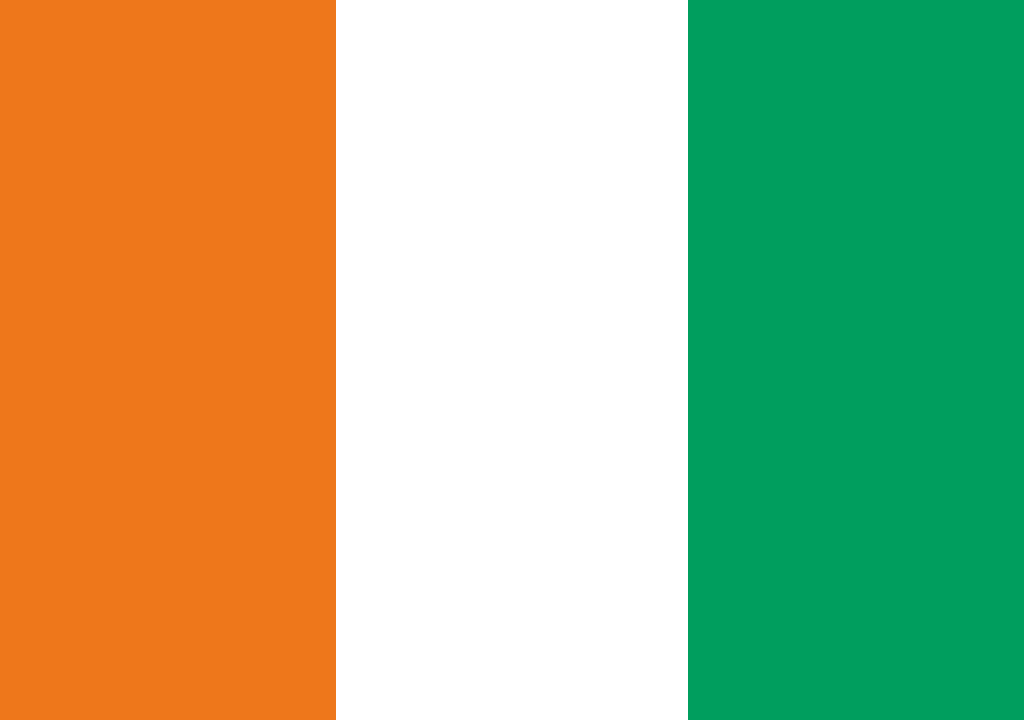
3 colors: orange, white, green.
Meaning of the flag of Ivory Coast (Cote d’Ivoire): Orange represents the land in the fertile areas in the savannahs of the north; white symbolizes joys and happiness and also represents the fresh water flowing in the rivers; green symbolizes the coastal forests, hope and a bright future.
History of the Flag of Ivory Coast
The flag of Ivory Coast has three colors in vertical stripes: orange, white, and green, from left to right.
The orange represents the country’s landscape main color, with lots of savannahs and deserts, while the white represents peace, national unity, and the rivers Sassandra, Bandama, and Kamo. The green represents hope in a better future and the lush landscapes of the south.
The official meaning of the colors was formally defined on 3 December 1959 when the flag was adopted. At the time, the Minister of State Jean Delafosse stated that [the orange] “reminded the colors of our rich and generous land, the reason of our fight, the blood of the young people fighting for independence,” and that the white represented not only peace but the rightfully owned peace. The green would stand for hope and the assurance of a better future.
The French flag might have influenced the current flag of this former colony, although it has a closer resemblance to the Irish flag: the same colors, but green on the left and orange on the right. The flag of Niger has the same colors, which is no surprise considering both countries’ collective past.
Flag of Kenya
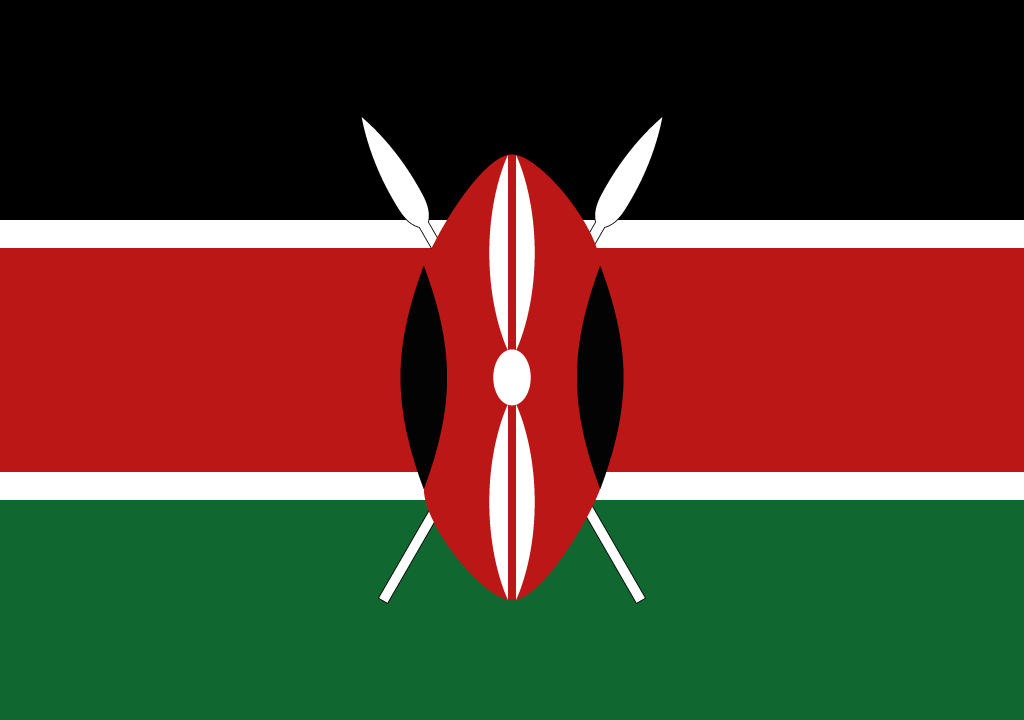
4 colors: black, red, green, white.
Meaning of the flag of Kenya: Black represents black majority in the country; red represents the blood spilt during the freedom fight; green stands for natural resources. The Maasai warrior shield with two spears protects all the above values.
History of the Flag of Kenya
The flag of Kenya is quite distinctive with three colors in three horizontal stripes, top to bottom, black, red, and green, and two thinner white lines bordering the red stripe. In the center, covering portions of all three stripes, a traditional symbol with a Maasai shield and two crossed spears.
The color choice of the flag of Kenya is not very common in Africa, where black is rarely used, and most countries prefer the green-yellow-red color scheme associated with the Pan-African movement.
Black represents the country’s population, red represents the blood that was shed while fighting for independence, and green represents the primary color of the national landscapes. Just like we’ve seen in the flag of The Gambia, the white lines represent union and peace.
Another interpretation of this flag, as we’ve seen with the flags of other African countries, is that these are the colors of Kenya’s leading political party, Kenya African National Union (KANU), and the white lines might represent the main opposition party, Kenyan African Democratic Union-Asili (KADU-ASIL).
The weapons in the center of the flag symbolize the willingness of Kenya’s people to fight for their country.
The flag was officially adopted on 12 December 1963, the day the country became independent from the United Kingdom.
Flag of Lesotho
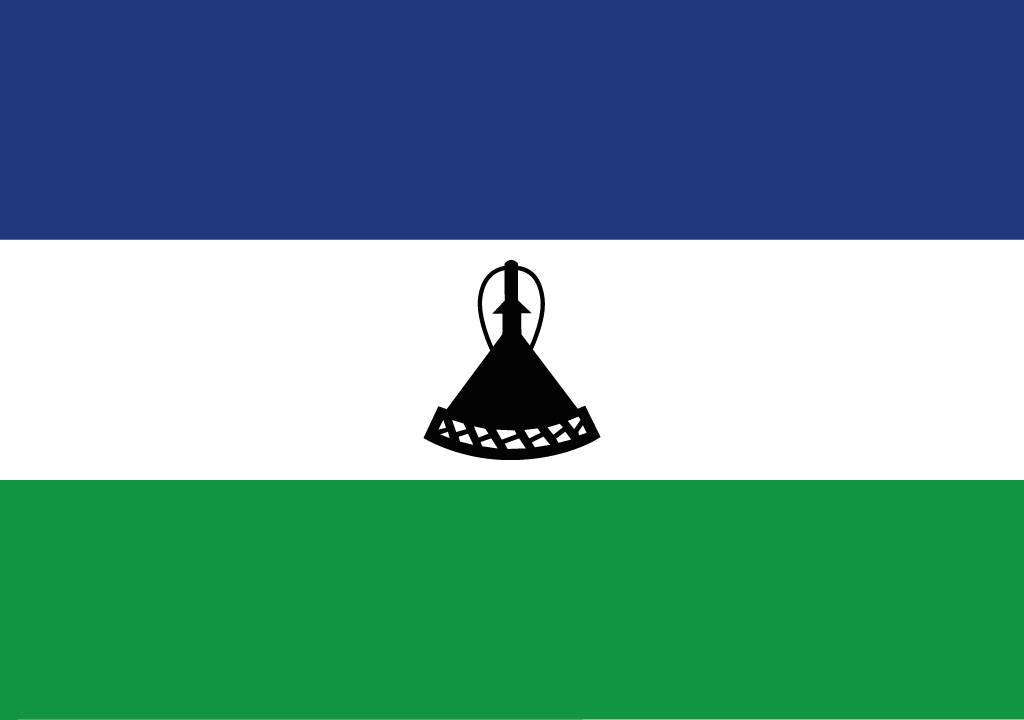
4 colors: dark blue, white, green, black.
Meaning of the flag of Lesotho: Blue symbolizes rain and water; white represents peace; green symbolizes prosperity. The Mokorotlo (the traditional Basotho straw hat) represents the indigenous Basotho (Southern Sotho) people.
History of the Flag of Lesotho
The flag of Lesotho has a simple color scheme, with three horizontal stripes in blue (top), white (middle), and green (bottom). In the center, over the white stripe, there’s a black depiction of a traditional straw hat wore in the country called mokorotlo, that became the country’s national symbol.
Blue represents sky and rain, green represents prosperity, and white represents peace, something that Lesotho’s people care much about.
Lesotho became independent in 1966 and it’s had several flags since then. The original flag, adopted that year, didn’t survive the military coup that overthrew the Basotho National Party in 1987, in power since independence. At that time a new flag appeared, designed by sergeant Retšelisitsoe Matete, with the same colors of the current flag but laid in a different order and with a military symbol instead of the mokorotlo.
In 2006 Lesotho wanted to change the flag to remove the military symbol and convey a message of peace. All four proposals included the mokorotlo in brown, which was later switched to black to represent the country’s black population. The new flag was officially adopted on 4 October 2006.
Flag of Liberia
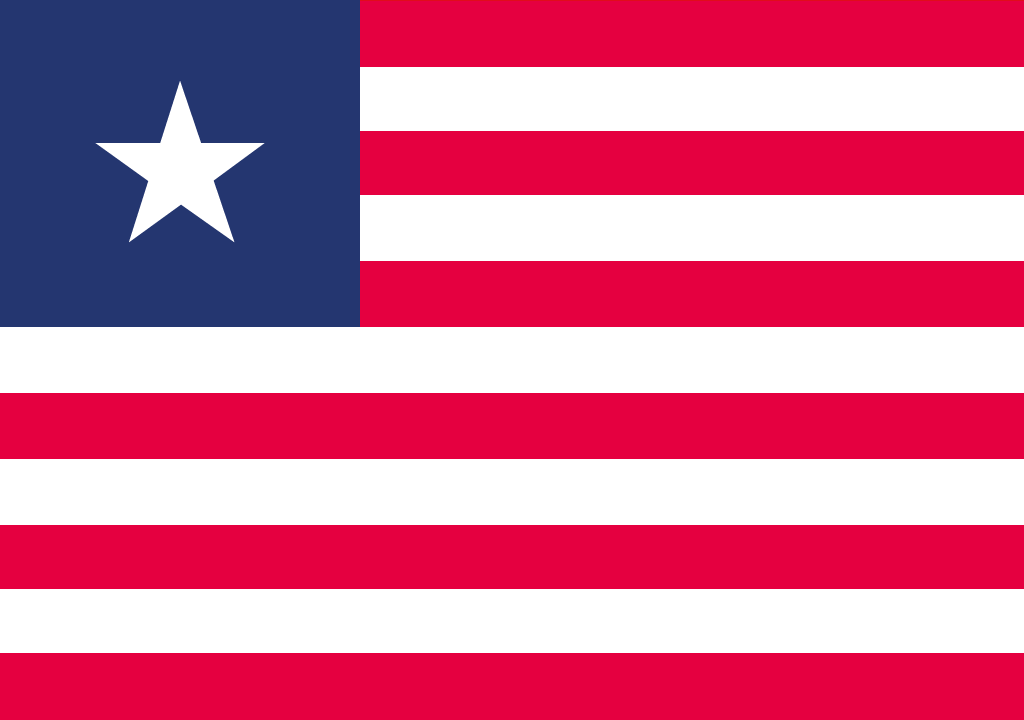
3 colors: red, white, dark blue.
Meaning of the flag of Liberia: Red and white symbolize the courage and moral excellence of the eleven signatories of the Liberian Declaration of Independence, represented by the eleven stripes.The white star stands for the freedom that the ex-slaves were given; the blue square represents the African mainland.
History of the Flag of Liberia
The flag of Liberia is clearly influenced by the USA flag, a rare case in Africa. That is connected to the curious History of the lands that are now known as Liberia, which translates into “Land of Freedom.” They dreamed of the utopian return of former slaves and their descendants from the United States to Africa.
Claiming independence in 1847 (recognized by the USA in 1862), Liberia is one of the oldest countries in Africa but kept its emotional and political ties with the United States until the 20th century.
The layout of the Liberian flag is the same as the USA one, with a few differences: there is a white five-point star in the top left corner, and 11 white and red stripes, unlike the 13 we see in the American flag.
The symbolism is also different: the stripes represent the 11 people who signed the country’s declaration of independence, the red symbolizes courage, and the white represents excellence.
As for the star, it represents Liberia as the first African independent country (the blue rectangle represents Africa) and the first with a Western-style democratic political model.
It’s probably Africa’s oldest national flag, officially adopted on 26 July 1847. It’s a famous flag that you’ll see on thousands of ships, considering the country issues permits very quickly and with very appealing conditions.
Flag of Libya
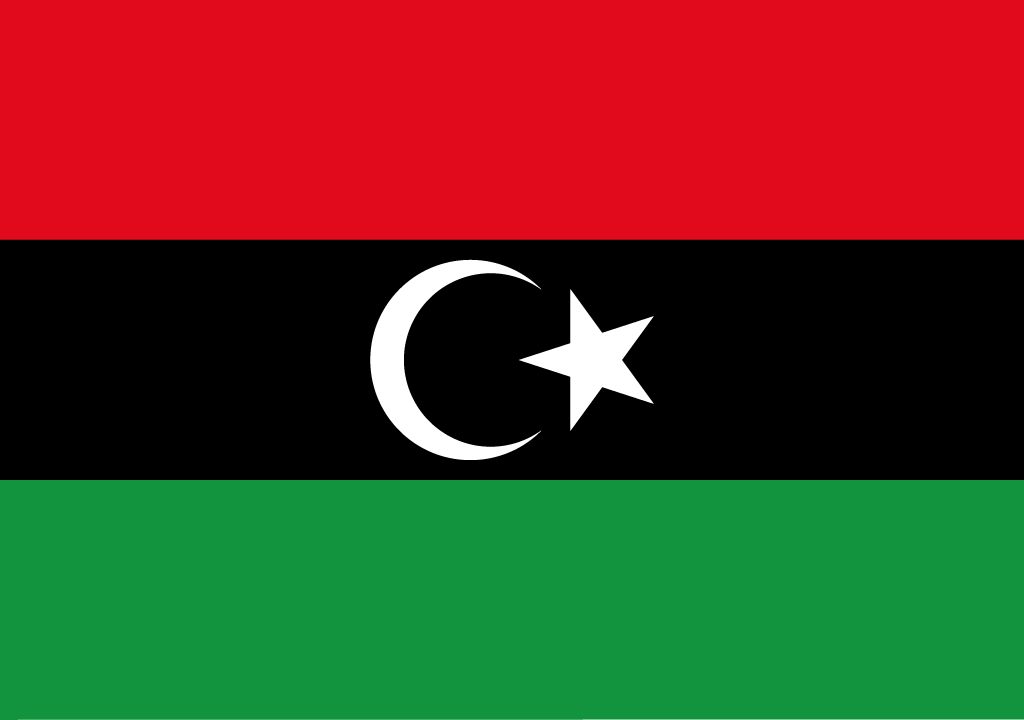
4 colors: red, black, green, white.
Meaning of the flag of Libya: Red stands for the blood of the Libyan people who died during the fascist rule of Italy; green represents peace. The crescent and star on a black background was inspired in the design of the banner used during the Senussi Dynasty, founded in Mecca in 1837.
History of the Flag of Libya
The current flag of Libya has three horizontal stripes: red on top, a more full black stripe in the middle, and green on the bottom. In the center, a white five-point star and Crescent Moon laid over the black stripe.
Although it went through significant changes since the creation of the kingdom of Libya in 1951, the national flag has come full circle returning to its original concept, in 2011.
The flag was inspired by the one used by the Senussi dynasty, from Cyrenaica, black and with a Crescent Moon and star.
It wasn’t proved that the flag was created by Omar Faiek Shennib, the Vice-President of the National Assembly and Minister of Defense of King Idris Al Senussi. But it was him who first presented the concept.
According to Omar Faiek Shennib, the red symbolizes the blood that was shed during the fights for independence, black symbolizes the dark times when Italy ruled Libya, and green symbolizes the national agriculture industry. The Crescent Moon and the star are a reference to the Senussi dynasty and the importance of king Idris Al Senussi.
The flag was used from the country’s inception until 1969 when the revolution led by Kadhaffi happened. Between that year and 1972, they used a three-color flag with the colors of the Pan-Arabism just like it had happened in Egypt in 1952. Between 1972 and 1977, the flag represented the union with Egypt and Syria, and between 1977 and 2011 the flag of Libya was totally green.
On 17 February 2011, the first flag of independent Libya was officially adopted.
Flag of Madagascar
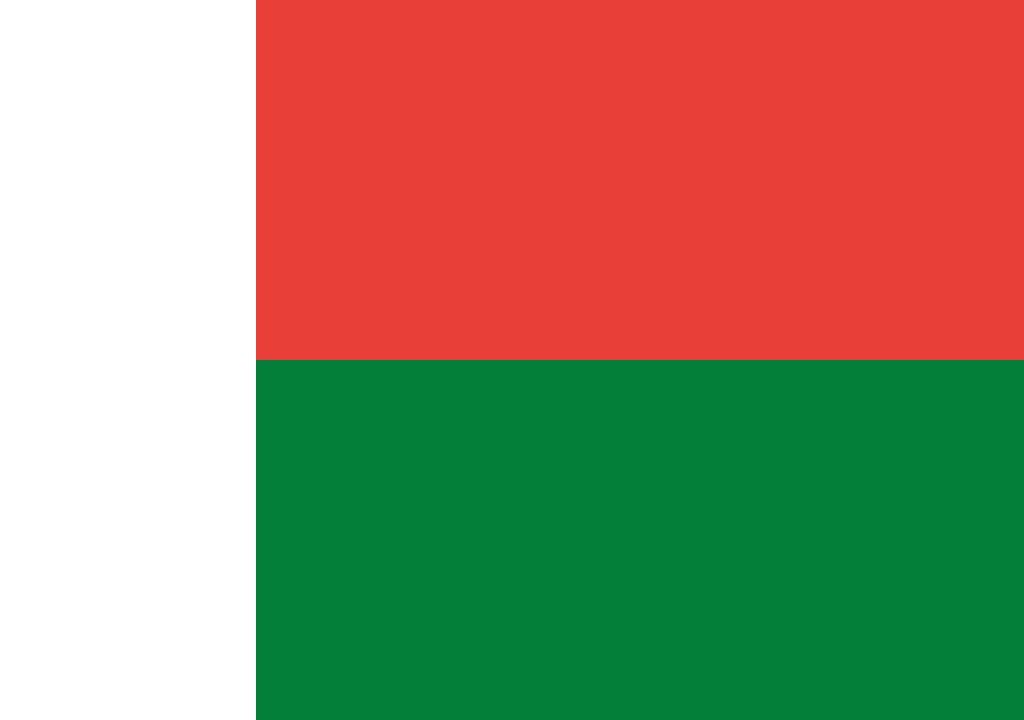
3 colors: white, red, green.
Meaning of the flag of Madagascar: Red represents the sovereignty of the country; green symbolizes hope; white stands for purity.
History of the Flag of Madagascar
The flag of Madagascar has three areas: one white on the left side taking over 1/3 of the flag, and 2/3 with two horizontal stripes (top red and bottom green).
Initially, the flag was mostly white as a tribute to the Merina dynasty and their effort to keep Madagascar’s independence at a time when the rest of the continent was conquered and controlled by Europeans. They resisted until 1866. The white represents purity and chastity, red represents the country’s independence, and green represents Madagascar’s people hope in a better future.
Another interpretation claims the green represents the population living by the coast, white represents the Volafot clan, and red represents the Volamen clan.
The flag was officially adopted on 14 October 1958, two years before the independence, and hasn’t been changed since.
Flag of Malawi
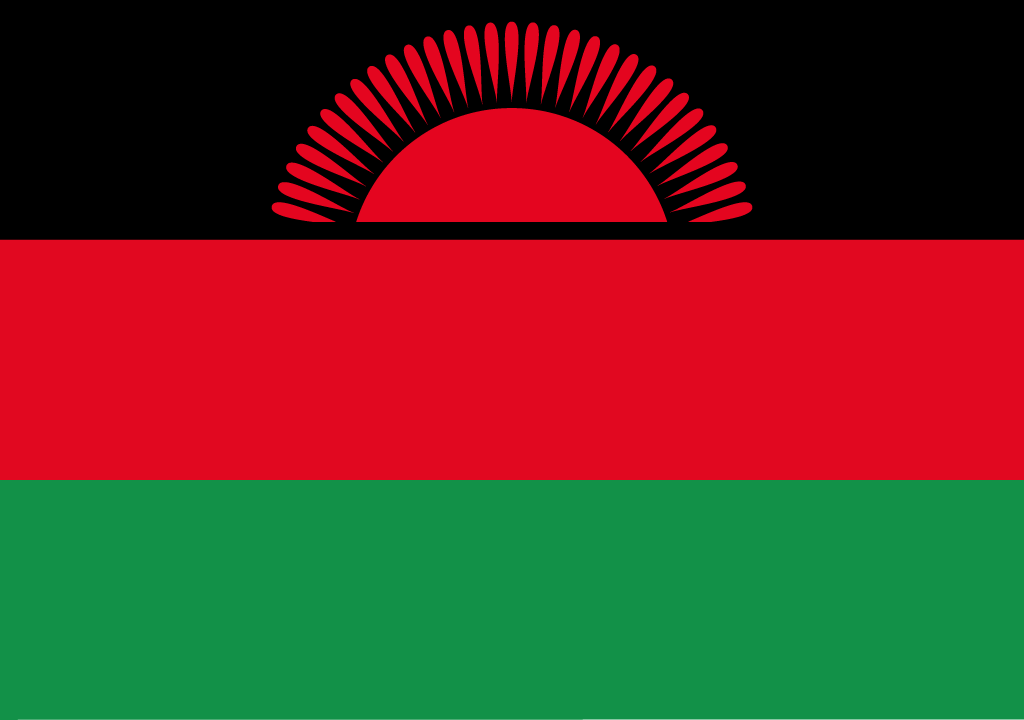
3 colors: black, red, green.
Meaning of the flag of Malawi: Black represents the African people; red symbolizes the blood spilt for their independence struggle; green stands for the country’s fertile lands. The rising sun over the black background symbolizes freedom and hope of the people in the African continent.
History of the Flag of Malawi
The flag of Malawi has three horizontal stripes: one black stripe in the top (with a symbol of a rising sun overlaid in the center), one red in the middle, and one green in the bottom.
The black stripe symbolizes the country’s people, the red represents the blood that was shed in the fight for independence, and the green represents the lush vegetation in Malawi.
As for the sun with 31 beams, it has a double meaning: it symbolizes the birth of a new nation and the bright future ahead, and it’s a reference to the meaning of the name of the country. Malawi is the word for the natural effect that happens over the Lake Nyasa when the sun sets.
The flag was inspired by the flag of the country’s leading political party, Malawi Congress Party.
The flag was adopted on 6 July 1964, on Independence Day, and although it was changed in 2010, it returned to its original design in 2012.
Flag of Mali
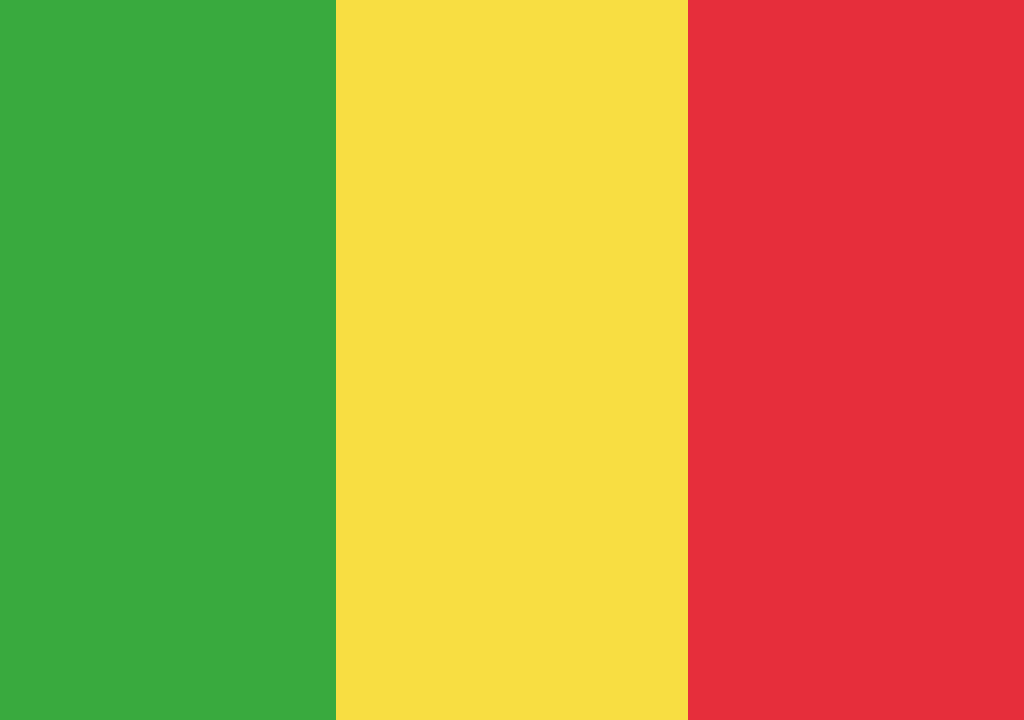
3 colors: green, yellow, red.
Meaning of the flag of Mali: Green represents the vegetation of Mali; yellow stands for purity and minerals in the country; red symbolizes the fight for independence.
History of the Flag of Mali
The flag of Mali is simple to describe: it’s a three-color flag with vertical stripes, green on the left, yellow in the middle, and red on the right. Those are the colors of the Pan-African movement where green symbolizes the forests and the land’s fertility, yellow represents the sun, and red represents the fight for independence.
When Mali became independent from France in 1960, it joined a political union with Sudan and Senegal, starting a federation. At the time the flag was similar to the current one, with an anthropomorphic symbol in the middle called Kanaga.
In 1961, when the federation ended, Mali adopted the current flag, on 1 March of that year. The Kanaga was removed from the flags of the federation’s former countries because there was an ideological conflict between Muslim’s religious beliefs and the use of a human figure in a flag.
Flag of Mauritania
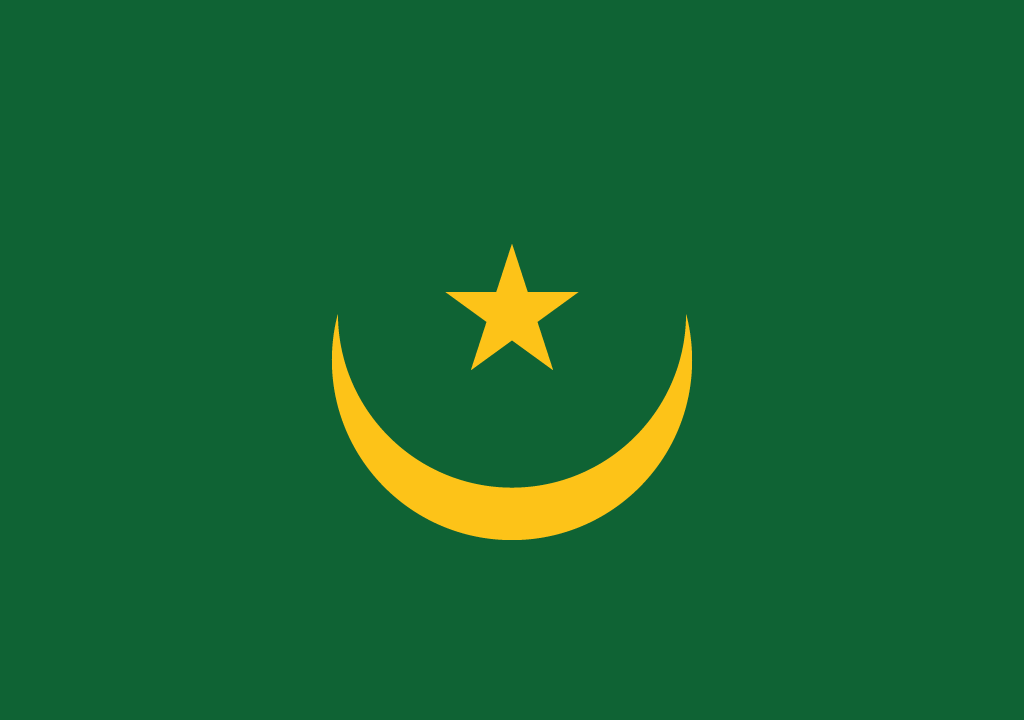
2 colors: green, yellow.
Meaning of the flag of Mauritania: Green represents Islam, as well as the star and crescent, which shows the faith of the Islamic Republic of Mauritania.
History of the Flag of Mauritania
The flag of Mauritania is mostly green, with one red stripe in the top and one in the bottom, and a yellow Crescent Moon and five-point star in the middle. However, unlike what happens in other flags with this Islamic symbol, in the Mauritania flag, the Crescent Moon is laid horizontally, with the tips of the moon pointing up.
According to some authors, the green symbolizes the country’s growth and bright future, while yellow represents Mauritania’s deserts.
The flag combines elements of the Pan-African movement, the colors yellow, red, and green, and religious elements (the symbols and the color green, the color of Islam).
The current flag was officially adopted on 15 August 2017, replacing the old flag that didn’t include the red stripes and that was used since the country’s independence, chosen at the time by president Moktar Ould Daddah.
The replacement took place after a national referendum promoted by president Mohamed Ould Abdel Aziz.
The red stripes symbolize the efforts and the sacrifice of the people of Mauritania when defending their country.
Flag of Mauritius
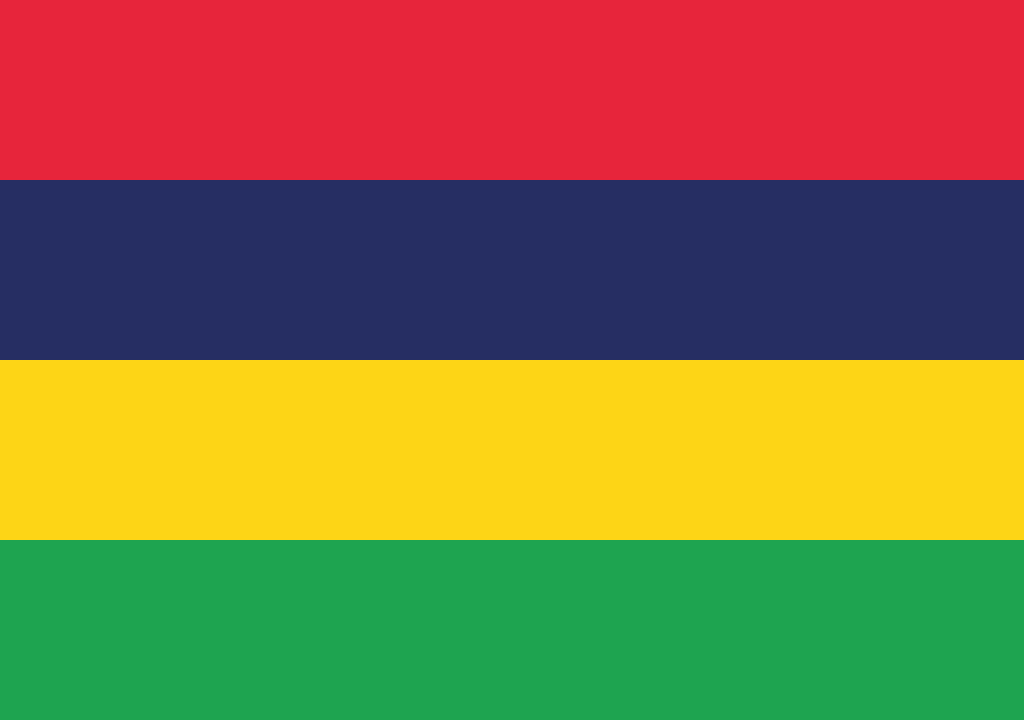
4 colors: red, blue, yellow, green.
Meaning of the flag of Mauritius: Red symbolizes the spilt blood during the freedom fight; blue stands for the Indian Ocean on which the island is located; yellow represents the golden ray of freedom; green symbolizes greenery and agriculture in Mauritius.
History of the Flag of Mauritius
The flag of Mauritius has four horizontal stripes: red in the top, blue and yellow in the middle, and green in the bottom.
It’s the same color scheme as the Pan-African movement, but it’s most likely a coincidence considering these are the same colors used in the islands’ coat of arms, given by King Edward VII in 1906.
The red symbolizes the fight for freedom and independence, the blue symbolizes the Indian Ocean that encircles the Mauritius islands, the yellow symbolizes the light brought by sovereignty, and the green symbolizes the country’s agriculture and landscape.
The flag was designed by an elementary school teacher, Gurudutt Moher, and adopted on Independence Day, 12 March 1968.
Flag of Morocco
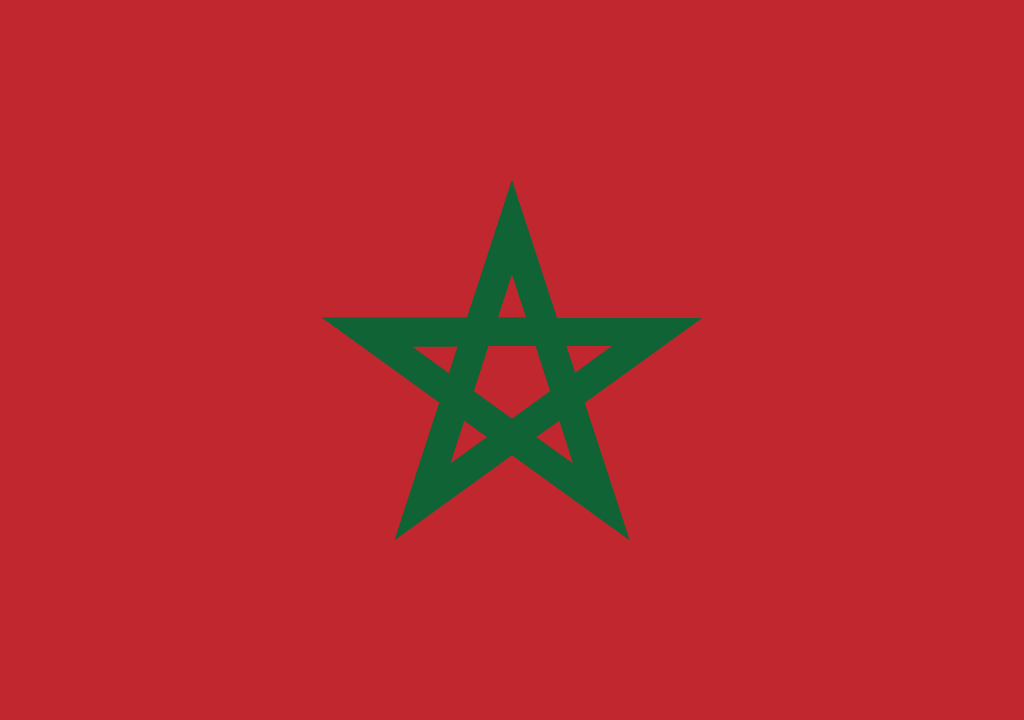
2 colors: red, green.
Meaning of the flag of Morocco: The red color in the flag has several important meanings for Morocco: it symbolizes the royals, including the Alaouite family, rulers in the seventeenth century, the Sherifs of Mecca and the Imams of Yemen. Red also represents the bravery and strength of the Moroccan people. The green five-pointed star is a pentagram symbolizing religion.
History of the Flag of Morocco
The flag of Morocco is red, with a green pentagram in the center, known as the “Seal of Solomon.”
The red, the primary color of the flag, symbolizes the blood union between prophet Mohamed and the king of Morocco, but it could also be interpreted as a representation of independence and the country’s sovereignty.
The red flag was adopted in the 17th century and the pentagram was added in 1915, during the kingdom of Mulay Yusef, as a symbol of love, truth, peace, freedom, justice, and the five pillars of Islam. The current flag was officially adopted on 17 November 1915 and remained the same even under Spanish and French ruling.
Flag of Mozambique
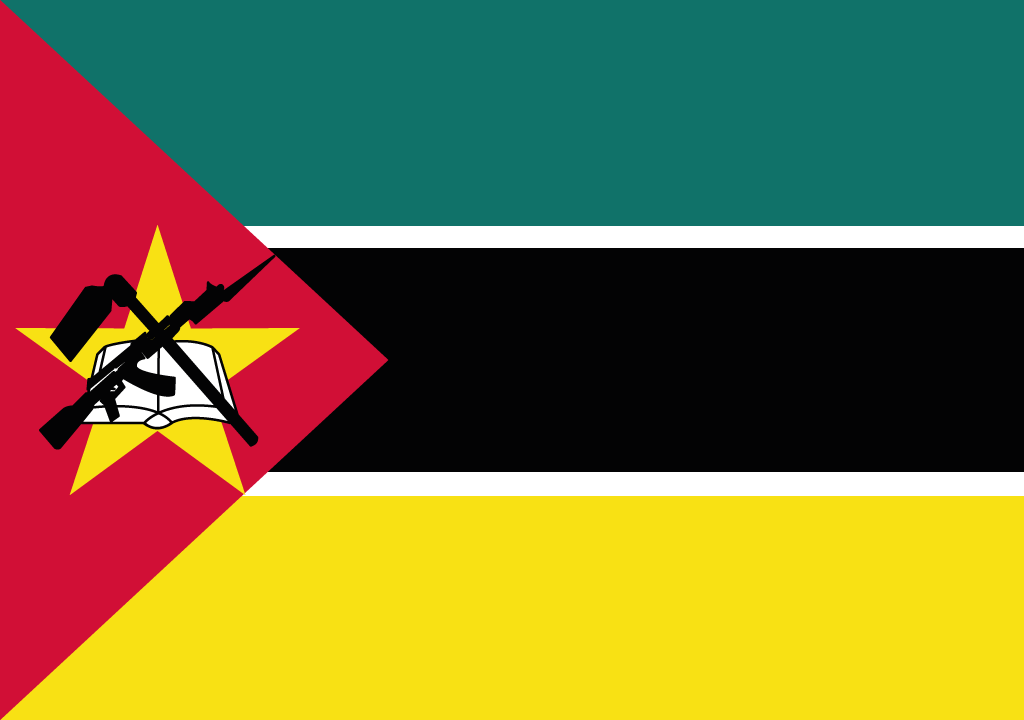
5 colors: green, red, black, yellow, white.
Meaning of the flag of Mozambique: Green represents the land; white stands for peace; black represents the African continent; yellow stands for the mineral wealth of the nation. The red triangle symbolizes the immense effort for independence. On the triangle, the yellow star represents the socialist beliefs of Mozambique; the book stands for education; the hoe represents the peasants and agriculture; the AK-47 rifle represents the nation’s determination to defend its freedom.
History of the Flag of Mozambique
The flag of Mozambique has three horizontal stripes, divided by two white lines, one green in the top, one black in the middle, and one yellow in the bottom. There’s a red triangle on the left, with the base covering all the left side and the vertex stretching out to one-third of the flag.
Over that red triangle, laid over a yellow five-point star, there’s a symbol of an AK-47 Kalashnikov assault rifle and bayonet that was the weapon of choice of the revolutionaries in the 1960s and the 1970s. There’s a hoe laid over the rifle that represents the Mozambican farmers and a book underneath representing the importance of education.
The flag was inspired by FRELIMO, the political party that organized the armed fight for Mozambique’s independence.
The green symbolizes the country’s fertile lands, black symbolizes the people of Mozambique, and yellow represents the mineral richness. The white represents peace.
Before the independence, that happened in 1975, the country chose a flag with the same layout but without the symbols over the red triangle. After the independence, they kept the colors but laid them differently and used the same symbols we see in the flag now. The current flag was officially adopted on 1 May 1983.
In 2005, there was a substantial change made to the flag, with a public competition that attracted 119 entries. The opposing party in the parliament wanted to remove the weapon symbol from the flag (there are only two other countries in the world with weapons in their flags), but FRELIMO impaired the change.
Flag of Namibia
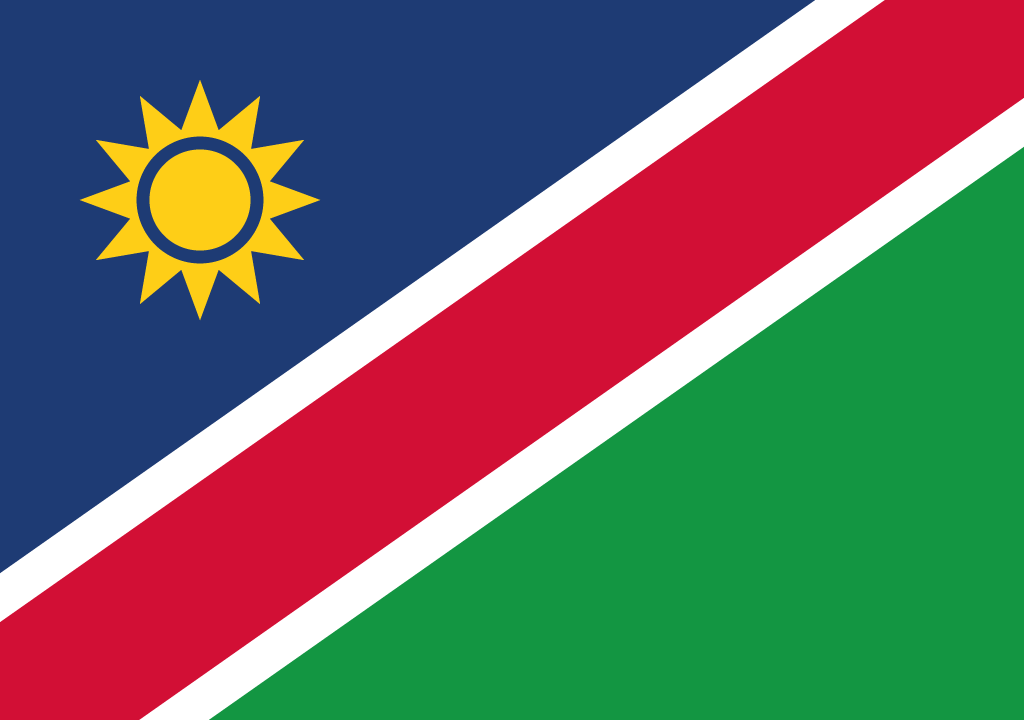
3 colors: yellow, green, red.
Meaning of the flag of Namibia: Blue represents the vast sky, rain and water; white signifies tranquility and harmony; green symbolizes plant growth and cultivation; red is for the valor of the Namibian people and their wish for people to be equals. The sun on the flag stands for power and existence.
History of the Flag of Namibia
The flag of Namibia has three separate areas. There’s a blue area on the top left side and a green area in the bottom right. A diagonal red stripe with a white border separates the two areas.
In the top left corner, there’s the symbol of a sun with 12 sunbeams that represent energy and life.
The meaning of the colors is officially defined as follows: the red symbolizes the people of Namibia, their heroism and determination to build a better future for all; the white symbolizes peace and union; the green represents agriculture and the country’s natural landscapes; the blue represents the ocean, the sky, the rain, and Namibia’s water resources.
The flag was adopted on 21 March 1990, when Namibia became independent from South Africa.
There was a lawsuit about the flag’s authorship, and the court ruled Theo Jankowski, Don Stevenson, and Ortrud Clay as co-authors. There were 870 applications for the public competition to choose the flag of the new country. Six designs made it to the finalists and of those, the proposals of those three men were selected. From then, they combined the concepts of all three designs into one flag, the one we know today. Two other plaintiffs lost the case.
Flag of Niger
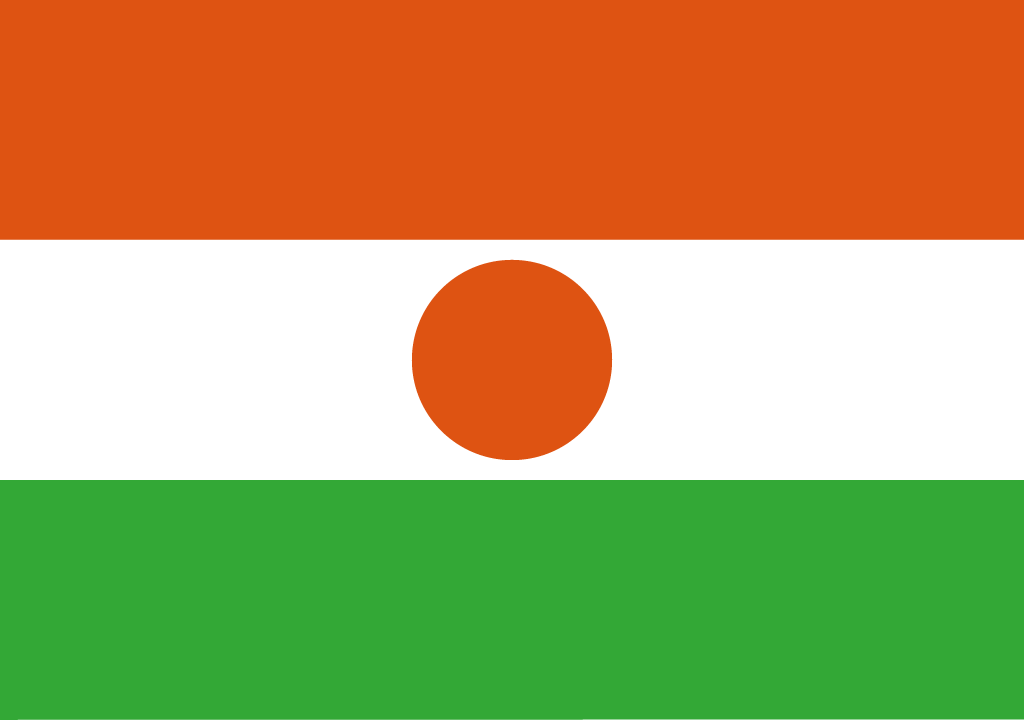
3 colors: orange, white, green.
Meaning of the flag of Niger: Orange symbolizes the Savannah grasslands in the northern regions of the Sahara Desert; white stands for purity and innocence; green represents the rainforests and the Niger River. The orange circle in the middle of the white stripe represents the celestial sun and the will of the state to protect its freedom.
History of the Flag of Niger
The flag of Niger was defined one year before the country’s independence. It has three horizontal stripes: orange in the top, white in the middle, and light green in the bottom. There’s a medium-sized orange circle laid over the white stripe in the center.
There’s a specific literal geographic symbolism to this choice of colors. Orange represents the scorching Sahara Desert in the north. White represents purity. As for the green, it represents vegetation, the country’s main landscape.
The circle is also a literal representation of the Niger’s sun.
The flag was adopted on 23 November 1959 and has remained the same until the present time.
Flag of Nigeria
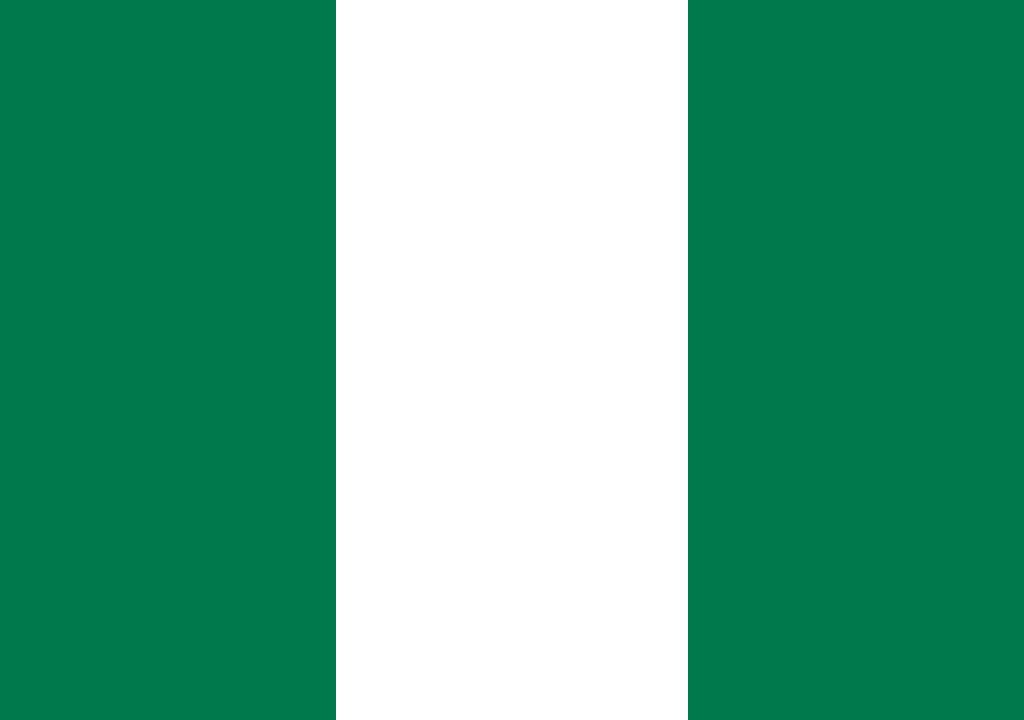
2 colors: green, white.
Meaning of the flag of Nigeria: The two green stripes represent agriculture and the dense forests of Nigeria; the white stripe symbolises peace and unity.
History of the Flag of Nigeria
The flag of Nigeria is simple: three vertical stripes, one white in the middle, and two green ones in the sides.
The flag was selected shortly after the independence from the United Kingdom, in 1960, and was created by 23-year-old student Michael Taiwo Akinkunmi, who studied at the time at the Norwich Technical College in England. The public competition was organized in 1959 and it got over 200 applications.
The flag designed by Michael Taiwo Akinkunmi had an additional symbol, a sun laid over the white central stripe.
There are two main interpretations of this flag. One claims the white represents Niger River, surrounded by the green Nigerian landscapes. Another one claims the white represents peace and green represents the country’s agricultural tradition.
The flag was adopted on Nigeria’s Independence Day, 1 October 1960.
Flag of Republic of Congo
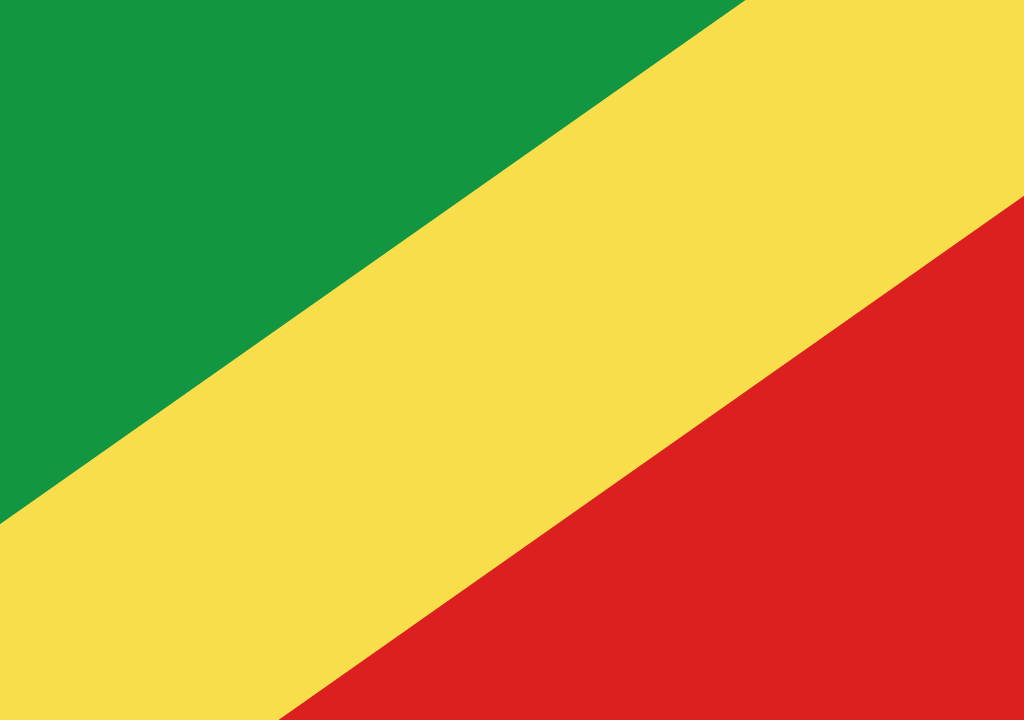
3 colors: green, yellow, red.
Meaning of the flag of the Republic of Congo: The colors green, yellow and red are the traditional Pan-African colors: green symbolizes agriculture and forests; yellow symbolises the friendship and nobility of the people; red stands for the struggle for independence.
History of the Flag of the Republic of Congo
The flag of the Republic of the Congo has two primary colors, green on the left and red on the right, and a diagonal yellow stripe across, from left to right.
This set of colors corresponds to the Pan-African movement and symbolize the union between African people. But in the flag of the Republic of the Congo, the green also symbolizes farming, and the country’s fields and yellow represents the friendliness of the Congolese people. Surprisingly, there’s no official interpretation for the red.
The current flag was adopted for the first time on 15 September 1959, after they became independent from France. However, between 1970 and 1991, under the regime supported by the Soviet Union, the flag was completely red with communist symbols. After the USSR collapsed, the regime didn’t make it, and the democratic government that followed brought back the original flag, adopted for the second time on 10 June 1991.
Flag of Rwanda
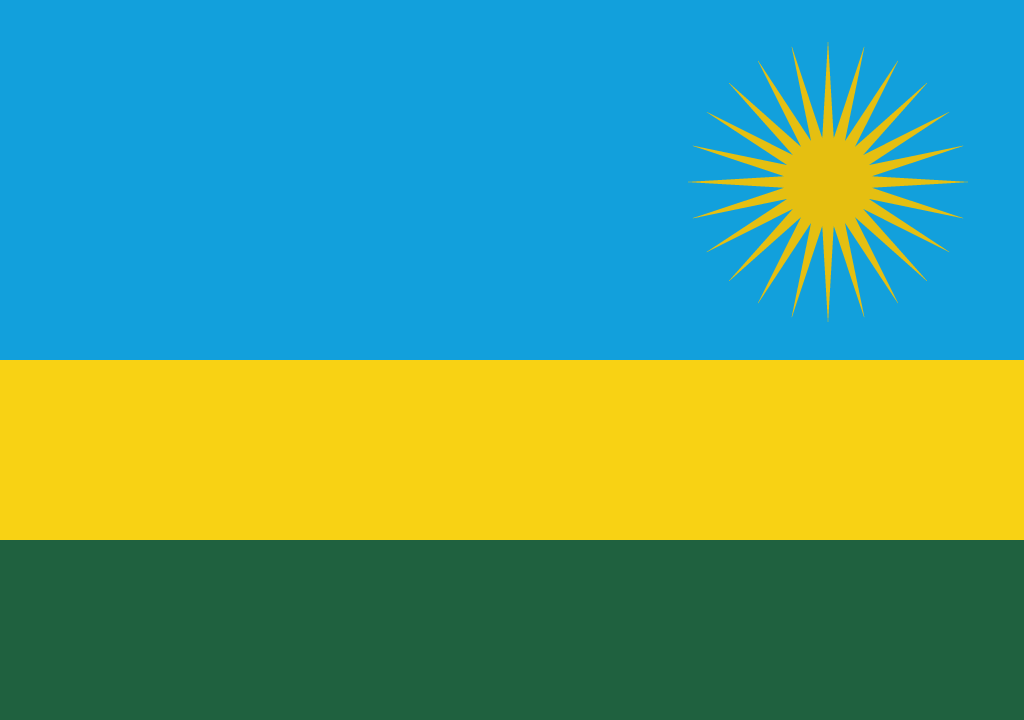
3 colors: blue, yellow, green.
Meaning of the flag of Rwanda: Blue represents happiness and peace; yellow symbolizes for the country’s mineral wealth and economic development; green represents the natural resources and prosperity of the Rwanda. The sun and its rays are for unity, transparency and enlightenment from ignorance.
History of the Flag of Rwanda
The current flag of Rwanda has three horizontal stripes. The top stripe that covers half the flag is blue, in a similar shade of the UN blue. The middle stripe is yellow, and the bottom stripe is green. There’s a sun in the top right corner, an unusual place to lay symbols in a flag.
The blue represents peace and happiness, yellow represents hope in a better future and economic development, and green represents prosperity and the country’s natural resources.
The sun symbolizes light, literally, and enlightenment, figuratively.
This flag was adopted on 25 October 2001, after Rwanda’s dark period when the Hutu majority slaughtered a large number of people of the Tutsi tribe. The former flag, used since the independence in 1961, was the same as the flag of Guinea but with the letter R in the center to tell them apart.
The flag was designed by Alphonse Kirimobenecyo, who intended for the flag to represent the movement of reconciliation after the massacres. It conveys the principles of national union, respect for work, heroism, and trust in the future.
Flag of Saint Thomas and Prince
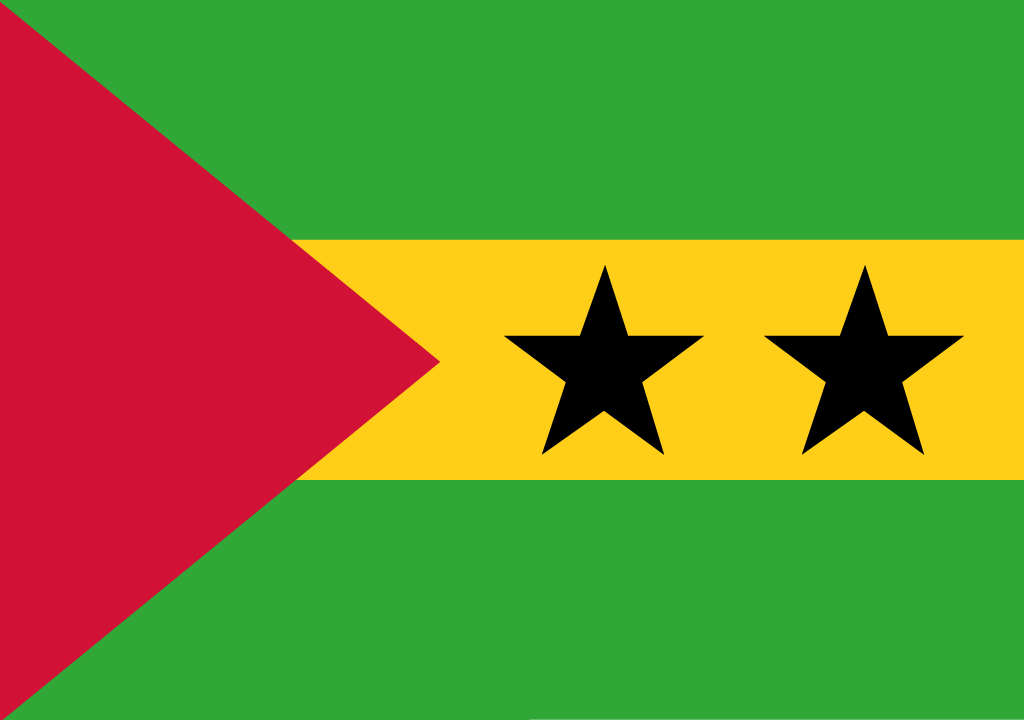
4 colors: green, yellow, red, black.
Meaning of the flag of Saint Thomas and Prince: Green, yellow and black are pan-African colors and also the colors of the Liberation Movement. The red triangle represents the hard fight for independence. The two black stars represent the two main islands of the country.
History of the Flag of Saint Thomas and Prince
The flag of Sao Tome and Principe has three horizontal stripes: yellow in the middle, and green in the top and bottom. On the left, a triangle laid horizontally with the vertex pointing to the middle of the flag. In the middle, laid over the yellow stripe, two black five-point stars.
There is an obvious connection to the Pan-African movement, that uses green, red, and yellow as a symbol of union between the African people and nations. But, in the specific case of Sao Tome and Principe, the green also represents the lush vegetation that covers all the islands in the archipelago and the yellow represents sun and cocoa, the country’s main product. The red honors the memory of those who fought for the independence of Sao Tome and Principe and is connected to the principle of equality.
The two stars represent the two islands that make up the country, but there’s also a connection with the Pan-Africanism star and its meaning of union.
The flag of Sao Tome and Principe was adopted on 5 November 1975, after a long process of refusing all the proposals made for the flag of the new country. The one selected is almost identical to the leading political party in the country, MLSTP (Movement for the Liberation of Sao Tome and Principe), and it was most likely designed by Manuel Pinto da Costa, historical leader of the MLSTP, who became president of Sao Tome and Principe.
Flag of Senegal
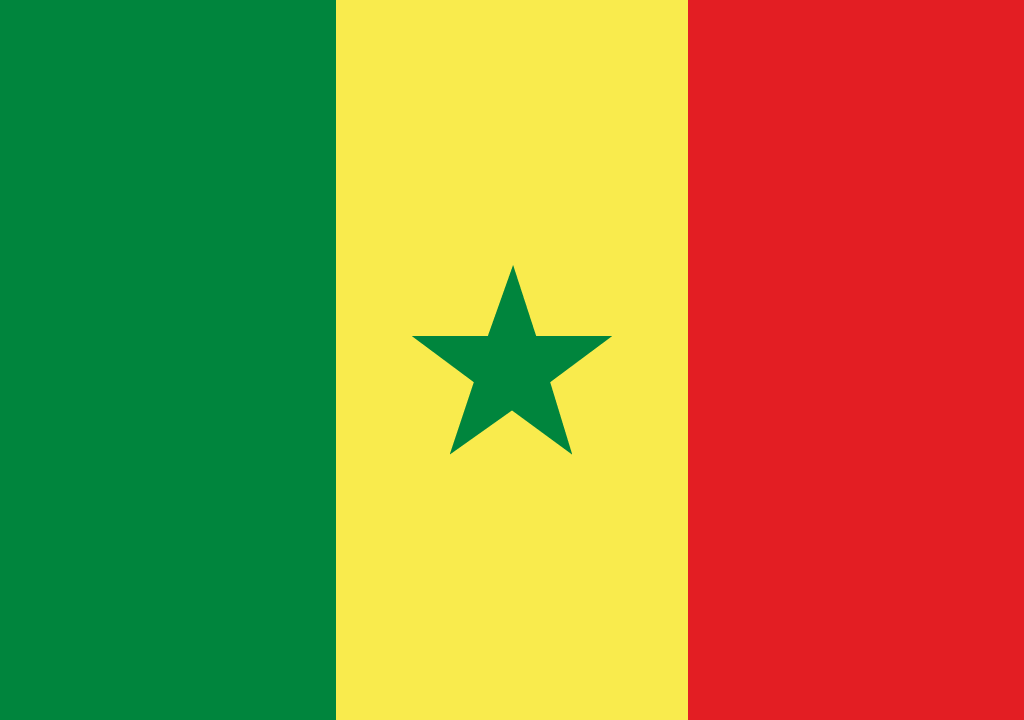
3 colors: green, yellow, red.
Meaning of the flag of Senegal: All the colors are pan-African ones. Green represents Islam, progress and hope; yellow stands for the natural wealth and progress of the Senegal, which will be obtained by the collective work of people; red is for the African peoples’ struggle for independence. The star represents unity and hope.
History of the Flag of Senegal
The flag of Senegal has three vertical stripes in three colors: green in the left, yellow in the middle, and red in the right. In the center, laid over the yellow stripe, a green five-point star.
As it happens with many other African countries, the colors of the flag of Senegal are the ones from the Pan-African movement, which got the same colors from the flag of Ethiopia, the only country in Africa that, despite being invaded and occupied by Italy, was never colonized.
In addition to that common meaning, the green represents the vegetation but also the influence of Islam in Senegal, and the yellow represents the sun, the arts, and the quality of life. As for the red, it symbolizes the blood that was shed during the fight for independence. The green star symbolizes the country’s openness to the five continents of the world.
There are a few elements worth pointing out: although the majority of the Senegalese population is Muslim and relates the green to Islam, the Christian minority sees the green as hope, and the animists interpret the green in the flag as a symbol of fertility.
On the other hand, it might not be a coincidence that the three colors of the flag are the same colors as the three main political parties in the country.
Between 1959 and 1960, Senegal was part of a political federation with Mali and Sudan, sharing a common flag. It’s basically the same flag Senegal uses today but had an anthropomorphic symbol in the center, the Kanaga, instead of the star.
The current flag was adopted on 20 August 1960 and used as it is until today.
Flag of Seychelles
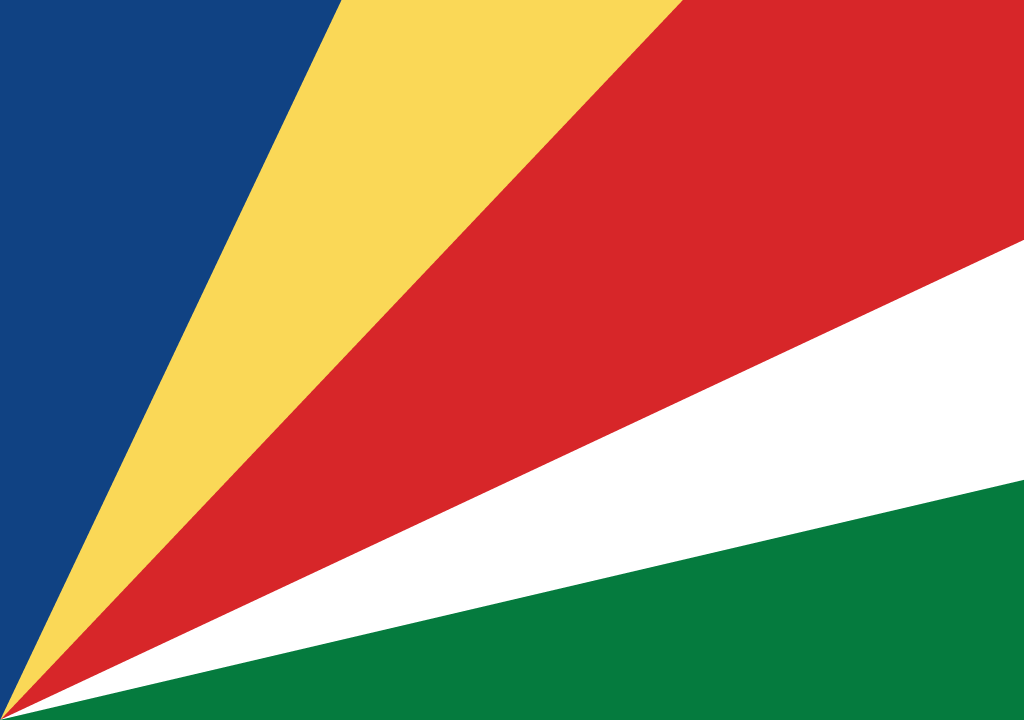
5 colors: blue, yellow, red, white, green.
Meaning of the flag of Seychelles: Blue represents sky and sea; yellow is for the sun giving light and life; red symbolizes the peoples’ determination to work for the future together in loving harmony; white represents justice and peace; green stands for the land and natural environment. The oblique bands are supposed to symbolize a dynamic new country moving into the future.
History of the Flag of Seychelles
Seychelles have one of the most colorful flags in the world, with five areas laid out as a colorful fan. From left to right the colors are blue, yellow, red, white, and green.
Together, the colors symbolize the young country’s approach to its future. Individually, blue represents the sky and the ocean encircling the archipelago, yellow represents the sun, red represents the people and their determination in building a better future, white represents harmony and social justice, and green represents the earth and the environment.
On the other hand, the colors correspond to the ones used by all political parties in the country.
The current flag was adopted on 8 January 1996, the third design in use since the independence from the United Kingdom in 1976.
Flag of Sierra Leone
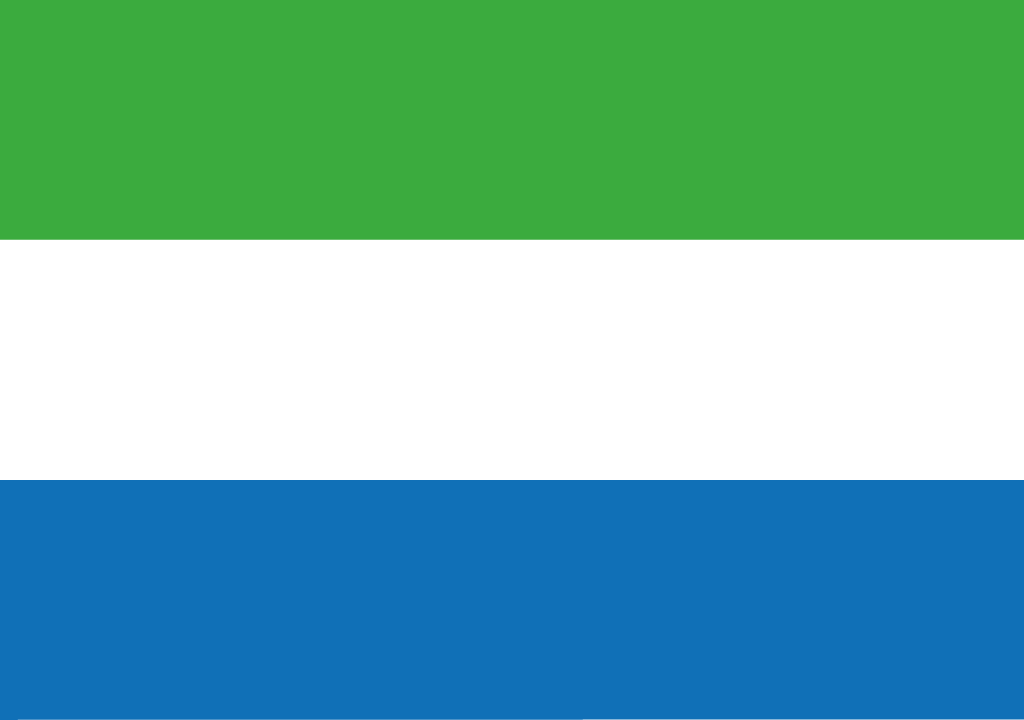
3 colors: green, white, blue.
Meaning of the flag of Sierra Leone: Green represents agriculture, mountains and natural resources; white stands for unity and justice; blue symbolizes the sea and the natural harbour in the capital Freetown.
History of the Flag of Sierra Leone
The flag of Sierra Leone is three-colored with horizontal stripes. From left to right, colors are green, white, and blue, a color selection similar to the flag of Gabon.
The green represents the lush vegetation of the country and its natural resources, blue represents the Atlantic Ocean, the port of Freetown, and the hope to contribute to world peace, and white represents peace, justice, and national union.
The current flag was adopted on 27 April 1961, the Independence Day, and has been used as it is ever since.
Flag of Somalia
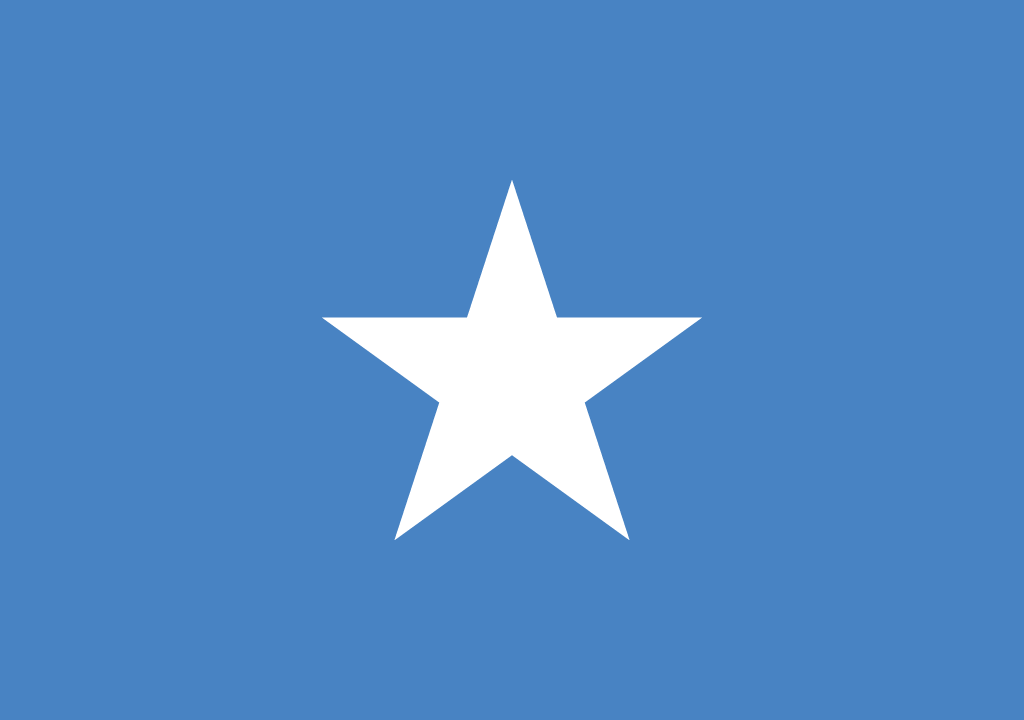
2 colors: blue, white.
Meaning of the flag of Somalia: The blue base color represents the blue sky over Somalia as well as the United Nations, who helped the country to become conscious about its dream of freedom. The five-point white star symbolizes liberty in Africa. Each of the five points stands for one of the historic realms occupied by the Somali people.
History of the Flag of Somalia
The flag of Somalia is mainly blue with just one white five-point star in the center.
The blue was initially used in the flag’s background as a tribute to the United Nations, that once administered the country, but currently, it’s interpreted as a symbol of the sky and the Gulf of Aden. The white star symbolizes the five places where Somalis live: Somalia, Djibouti, Somaliland, Ogaden (Ethiopia), and the provinces in the northeast of Kenya.
The flag was designed by academic Mohammed Awale Liban, a nationalist who later had several political roles in the country, and was adopted on 12 October 1954.
Flag of South Africa
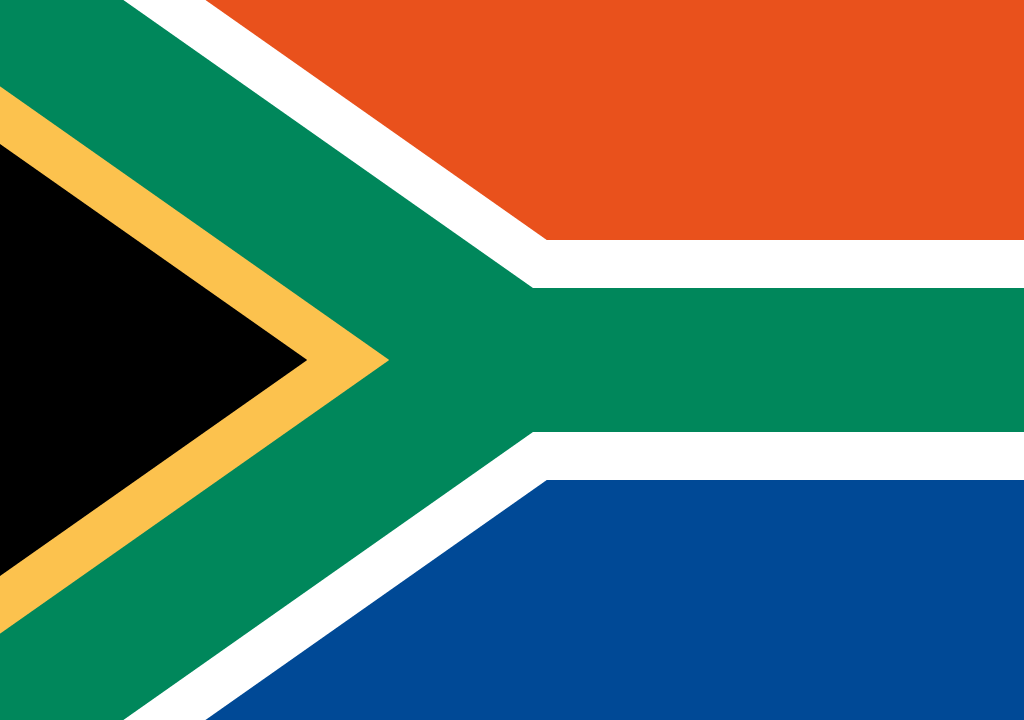
6 colors: red, green, blue, black, white, gold.
Meaning of the flag of South africa: Y represents the united country after the Apartheid regime. Red symbolizes blood; blue symbolizes the sky; green symbolizes the rich vegetation; black symbolizes African people; white symbolizes white people; gold color symbolizes the mineral gold. Red, white and blue also symbolizes South African past colonizers, Great Britain and The Netherlands.
History of the Flag of South Africa
The flag of South Africa is rather complex and includes a y-shaped geometrical figure laid horizontally, from left to right. That shape creates three distinct areas: black in the left, red at the top, and blue at the bottom. In addition to that, the y-shape has a yellow and a white border.
This flag was adopted after the first elections held in the country after the end of apartheid. It was designed in March 1994 by South Africa’s official flag specialist, Frederick Brownell, and officially adopted on 27 April of that year. It replaced the old flag, in use since 1928, and that included symbols of the colonial past such as the Union Jack and the resemblance to the Dutch flag.
A public competition for the new flag was launched, but none of the over 7,000 applications were considered acceptable. Of all the applications, six were selected to be presented and discussed, but none sparked enthusiasm. After that, they hired design companies, but there was still no agreement. In the end, the task was handed over to the official flag specialist.
The colors of the flag symbolize inclusiveness, representing all the groups that make up the country’s population. Yellow, black, and green are the colors of the National African Congress, the main political party in South Africa. Black represents the people, green represents fertility, and yellow represents the richness of the country’s subsoil. The red, white, and blue also represent the Dutch white minority, the Boers.
Flag of South Sudan
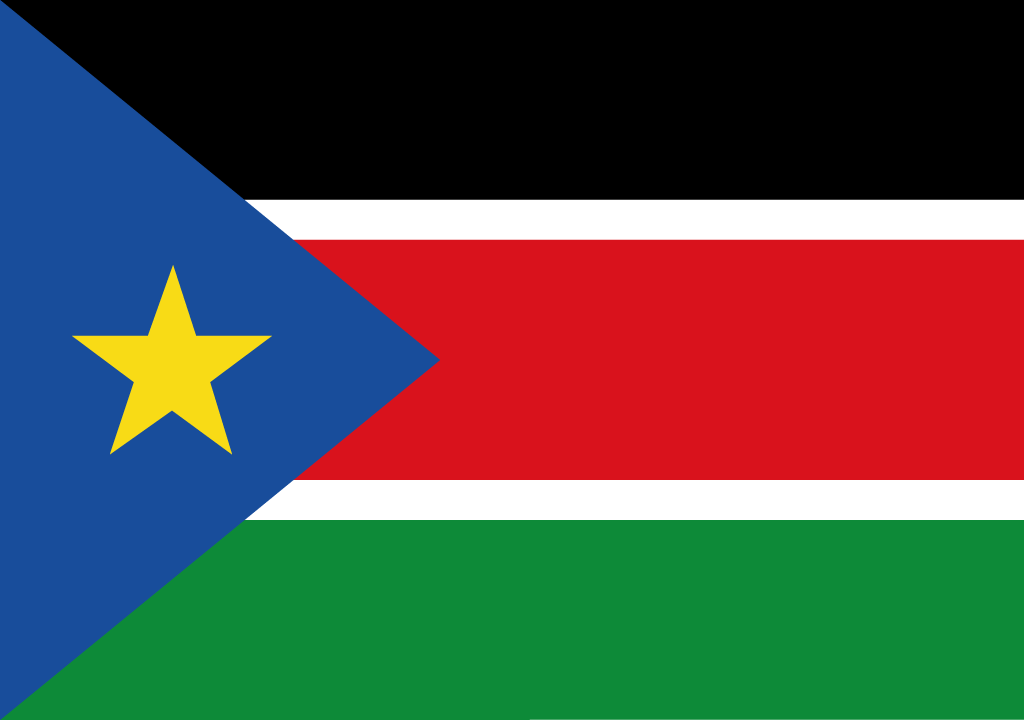
6 colors: black, red, green, blue, yellow, white.
Meaning of the flag of South Sudan: The colors are the Pan-Arab ones (white, red, green and black) and also blue and golden. They represent harmony and peace in the Arab world. Black symbolizes the South Sudanese people; white represents peace, harmony, brightness and hope; red symbolizes the blood spilt for freedom; green represents Islam, the growth of territory, and cultivation; blue stands for the waters of the Nile. The yellow star in the triangle (the Star of Bethlehem) signifies unity of the states of South Sudan.
History of the Flag of South Sudan
South Sudan is a very recent country and so is its flag, with three horizontal stripes separated by two thin white lines. The top stripe is black, the middle stripe is red, and the bottom stripe is green. On the left side, there’s a triangle, with the base covering all the left side of the flag and the vertex pointing to the center of the flag. Laid over that triangle, a yellow five-point star.
That flag was originally the one used by Sudan People’s Liberation Movement and later adopted as the national flag of South Sudan, which happened officially on 9 July 2005, six years before the independence.
The flags of Sudan and Kenya influenced the colors and the design.
Black represents the nation, red represents the blood that was shed during the fight for independence, green represents the earth’s fertility, and blue represents the Nile River. The yellow star, a universal symbol of union, represents the union of the several nations that became South Sudan.
Flag of Sudan
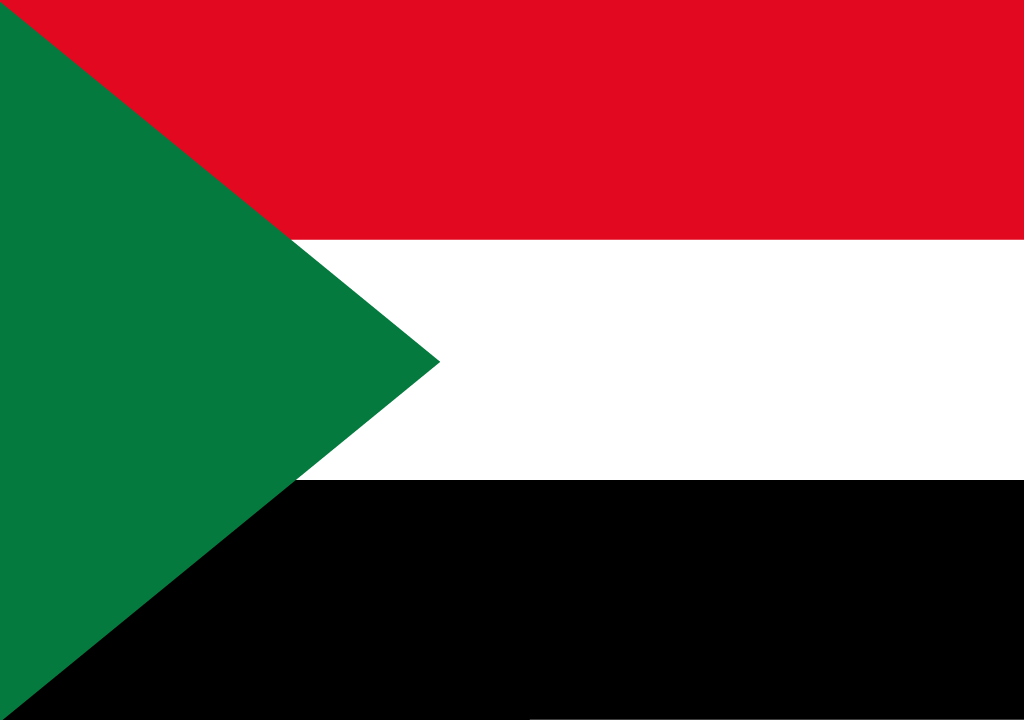
4 colors: red, white, black, green.
Meaning of the flag of Sudan: The colors of the flag represent harmony and freedom in the Arab world. Red symbolises the battle for liberation and various other conflicts as well as the loss of lives of the brave fighters; white represents harmony, brightness and hope (white also symbolizes the White Flag League, a patriotic faction which rebelled against the settlers in 1924); black is the symbol of the country, since the word “Sudan” means black in Arabic language, and also stands for the black insignia of the fighters of independence who fought against the settlers during the Kimokino rebellion in the last years of the 19th century; green represents Islam, the growth of the territory and cultivation.
History of the Flag of Sudan
The flag of Sudan has three horizontal stripes: red in the top, white in the middle, and black in the bottom. On the left side, a green triangle with the base completely covering the left side of the flag and the vertex pointing towards the center.
These four colors are inspired by the color scheme of the Pan-Arab movement, historically connected to the Arab people and Islam. They symbolize the union between Arab countries and their sovereignty over the outside world.
At a national level, red represents Sudan’s fight for independence and the sacrifices endured by the Sudanese martyrs. White represents peace and optimism, as the nationalist group White Flag League, who rebelled against the colonial occupation in 1924. Black represents Sudan itself (in Arab, Sudan means black) and it’s also a tribute to the nationalists, who fought during the Mahdist Revolution at the end of the 19th century and who used a black flag. Green represents Islam, agriculture, and earth’s fertility.
The first national flag of Sudan appeared on 1 January 1956 when the country became independent from the United Kingdom and Egypt. At the time, the flag had three horizontal stripes in blue, yellow, and green, which symbolized the Nile River, the desert sands, and the country’s vegetation respectively.
The current flag was adopted on 20 May 1970.
Flag of Swaziland
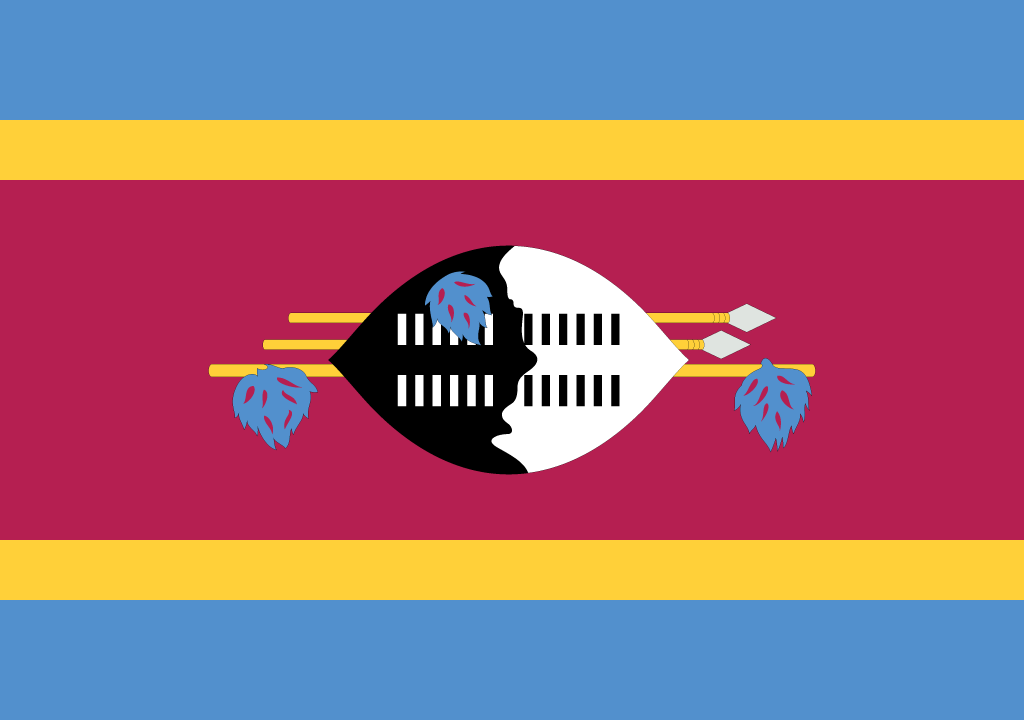
5 colors: blue, yellow, red, black, white.
Meaning of the flag of Swaziland (now called Eswatini): Blue represents peace and stability; red symbolizes past struggles; yellow stand for the mineral resources of the country. The shield, spears and staff symbolize protection from the country’s enemies. The black and white of the shield represent black and white people living in harmony.
History of the Flag of Swaziland
The flag of Swaziland has a wider central stripe, in red, with thinner blue stripes in the bottom and the top. Separating them, two thin yellow lines.
Laid over the red stripe in the center, a symbol that includes a Nguni shield in black and white, two spears, one stick, and three blue feathers.
The symbol represents the determination of the people of Swaziland in fighting to defend their country. The feathers symbolize the royal dynasty. The use of black and white in the shield conveys the idea of racial tolerance in Swaziland. The red stripe represents the blood that was shed for the nation, the blue stripes represent peace and stability, and the yellow stripes represent the country’s natural resources.
The flag dates back to 1941 when King Sobhuza II created it and offered it to the Swazi Pioneer Corps. That same flag was adopted on 6 October 1968, one month after the independence of Swaziland from the United Kingdom.
Flag of Tanzania
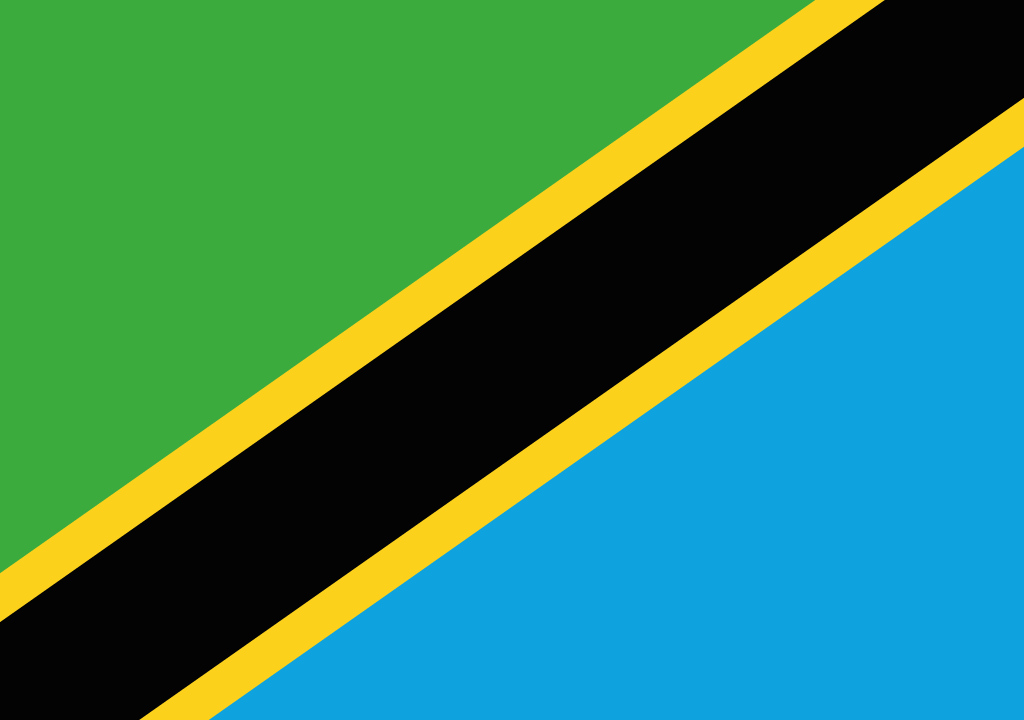
4 colors: green, black, blue, yellow.
Meaning of the flag of Tanzania: Green represents the fertile lands of Tanzania; yellow symbolizes the country’s mineral deposits; blue stands for the waters of Tanzania, including the Indian Ocean. The color black in the center symbolizes the people of Tanzania.
History of the Flag of Tanzania
The flag of Tanzania is mostly covered by the diagonal black stripe across it, with yellow borders, thus creating two distinct areas: a top left side in green and a bottom right side in light blue.
The flag of Tanzania is inspired by the flags of the regions of Tanganyika and Zanzibar, two regions that came together to create the country.
The green represents farming and the abundant vegetation of the national territory, and the blue represents Zanzibar and the influence of the Indian Ocean. Black represents the people of Tanzania, and yellow represents the richness of the country’s subsoil.
The flag was adopted when the country was created, on 30 June 1964.
Flag of Togo
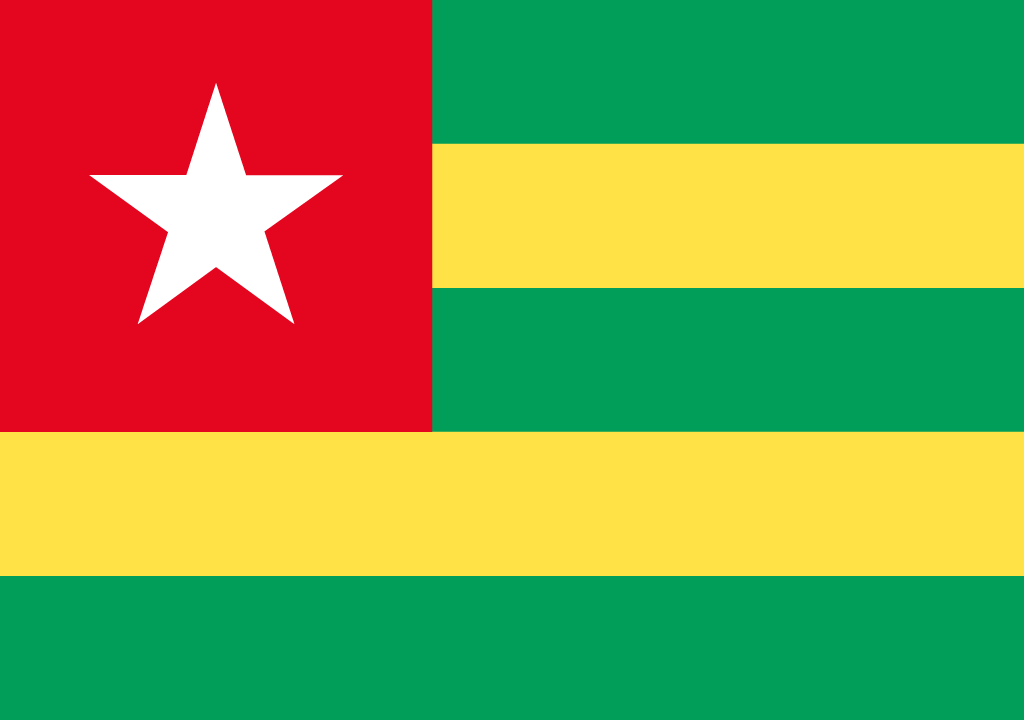
4 colors: green, yellow, red, white.
Meaning of the flag of Togo: The red square represents the loyalty and the patriotism of Togo’s people; green stands for hope, fertility and agriculture; yellow represents mineral wealth and the belief that hard work and strength will bring prosperity. The white star symbolizes life, purity, peace, dignity and Togo’s independence.
History of the Flag of Togo
The flag of Togo has five stripes, three dark green and two yellow. On the top left corner, covering about 1/6 of the flag, a red square with a white five-point star overlaid.
The color scheme follows the same one of the Pan-African movement, which got its inspiration from the flag of Ethiopia. Under the Pan-African movement umbrella, green, yellow, and red represent the union between the African people and nations.
Specifically speaking about the flag, red represents the blood that the nation martyrs shed in battle, the green represents farming, forests, nature, and hope in a better future, yellow represents the country’s natural resources, and the white reinforces the meaning of the star that represents hope.
As for the number of stripes, there are two different interpretations. One claims it represents five fingers and human behavior. The other claims the stripes represent Togo’s five regions: the coast, the plateau, the central area, Kara, and the savannahs.
The flag was designed by artist Paul Ahyi and adopted on 28 April 1960, two years after the independence, replacing the first flag of the country that was green with two white five-point stars.
Flag of Tunisia
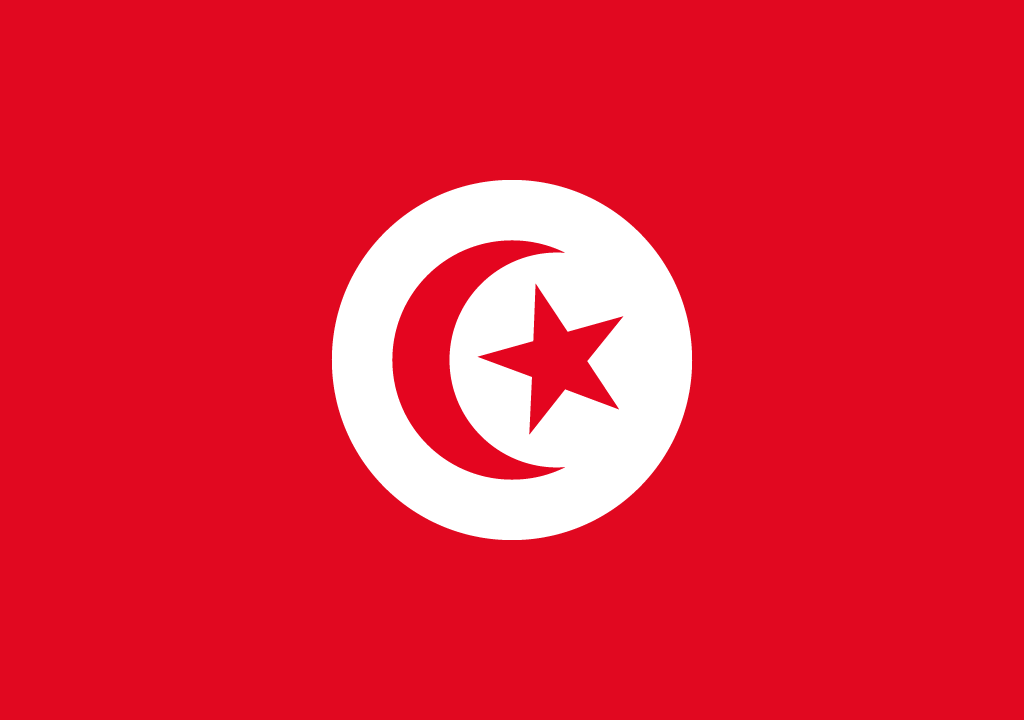
2 colors: red, white.
Meaning of the flag of Tunisia: Red represents the blood shed by martyrs in the struggle against oppression; white symbolizes peace. The crescent and star are traditional symbols of Islam considered to bring good luck and also recall Tunisia’s history as part of the Ottoman Empire.
History of the Flag of Tunisia
The flag of Tunisia is red with a white circle in the center. Inside that circle, there are a red Crescent Moon and a five-point star.
The primary color, red, represents the blood shed by the Tunisian when the French conquered them in 1831, but others claim the red symbolizes the light of all the Islamic universe.
White represents peace, and the white circle represents the sun that lights the nation. The Crescent Moon represents the unity of Muslims, and the five-point star represents the five pillars of Islam. However, before that religion appeared, the symbol of the Crescent Moon was already present in Carthage where is now Tunisia. There is a possibility that the old reference made its way into the current flag, at least partially. Both the Crescent Moon and the sun were commonly used in Carthaginian artifacts with religious meaning, specifically linked to the cult of goddess Tanit.
The historical roots of the flag of Tunisia go back to 1831 when it was first used by the navy of the kingdom of Tunis, with a strong influence from the flag of the Ottoman Empire. Something that was perfectly natural considering the existing historical ties.
After Tunisia became independent from France, in 1959, the old flag became the national flag, later revised in 1999.
Flag of Uganda
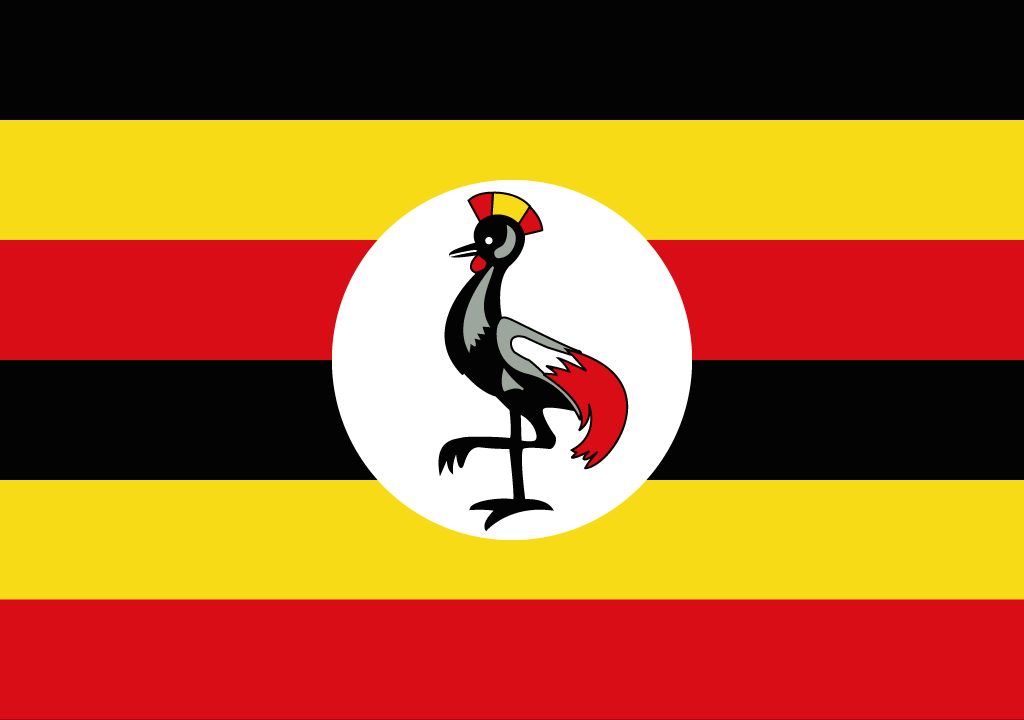
3 colors: black, yellow, red.
Meaning of the flag of Uganda: The colors of the flag of Uganda repeat from top to bottom. The black, yellow, and red are traditional pan-African colors; black represents the people of Uganda; yellow symbolizes sunshine; red represents the brotherhood and the blood that bonds the people of Uganda. The white circle in the center has a grey crowned crane standing on one leg, a gentle animal which is the national symbol of Uganda. The image of this animal was also used on the Ugandan military badges during British rule.
History of the Flag of Uganda
The flag of Uganda has six horizontal stripes, with the following sequence from top to bottom: black, yellow, red, black, yellow, red. In the center, inside a relatively small white circle, the national symbol of a grey-crowned crane. That bird is the symbol of Uganda and a part of the country’s coat of arms since it was run by the British. With a leg lifted, making it look like it’s about to take a step forward, it represents the country’s progress.
The colors of the flag match with the ones of the main political party of Uganda, Uganda People’s Congress (UPC), that dominates the country’s political scene since 1962. But the colors are also common in African countries’ flags because of their all-encompassing meaning: the black symbolizes the people, the yellow symbolizes the sun and the union between Africans, and the red represents the blood that all people in the continent share.
The flag was designed by Uganda’s Minister of Justice Grace Ibingira in 1962 and replaced a former flag, mostly green, that was used as a national flag in the months between independence and the first elections.
Flag of Zambia
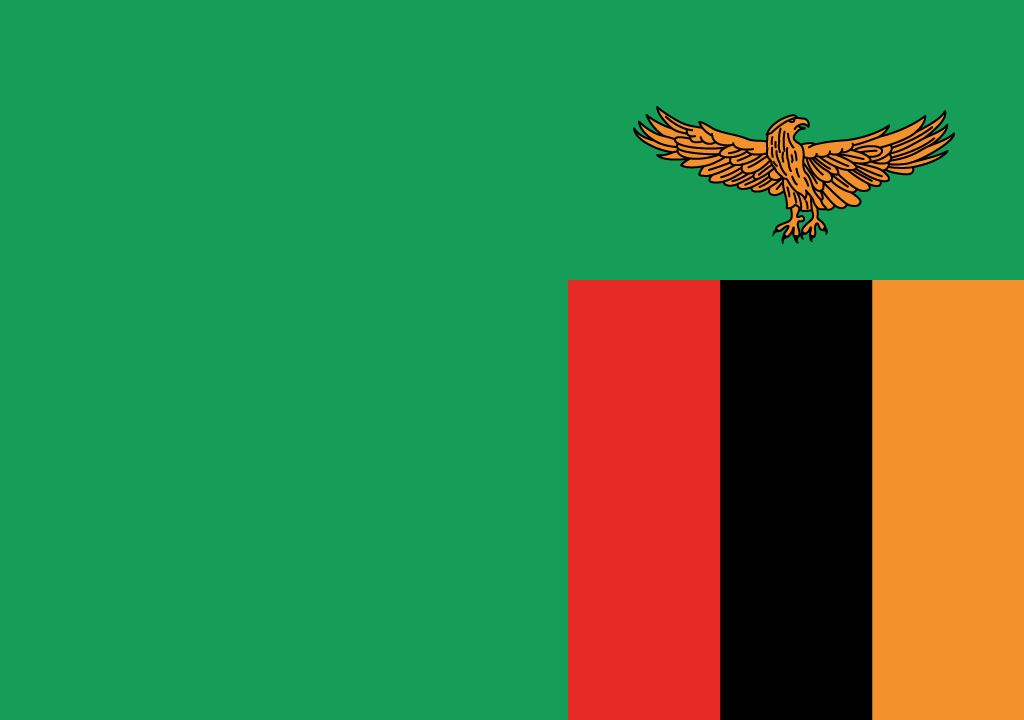
4 colors: green, red, black, orange.
Meaning of the flag of Zambia: Green symbolizes the fertile lands; red represents Zambia’s fight for freedom; black stand for the people of Zambia; orange is for the rich minerals and natural resources of the country. The eagle symbolizes the people of Zambia rising above the country’s problems.
History of the Flag of Zambia
The flag of Zambia is mainly green. On the bottom right corner, there’s a vertical set of three colored stripes: red, black, and orange from left to right. Above the stripes, on the green area, there’s an orange eagle that’s also part of the national coat of arms.
The primary color of the flag represents Zambia’s landscape, orange represents the richness of the country’s subsoil, the red represents the blood shed during the fight for independence, and the black represents the Zambian people.
The colors of the three stripes match the colors of the flag of the UNIP (United National Independence Party), the political party that led the fight for independence.
The eagle represents freedom and Zambia’s capacity to rise above the problems that might haunt the nation.
The flag was adopted when the country became independent and was hoisted for the first time as the official national flag on 23 October 1964 at midnight.
Flag of Zimbabwe
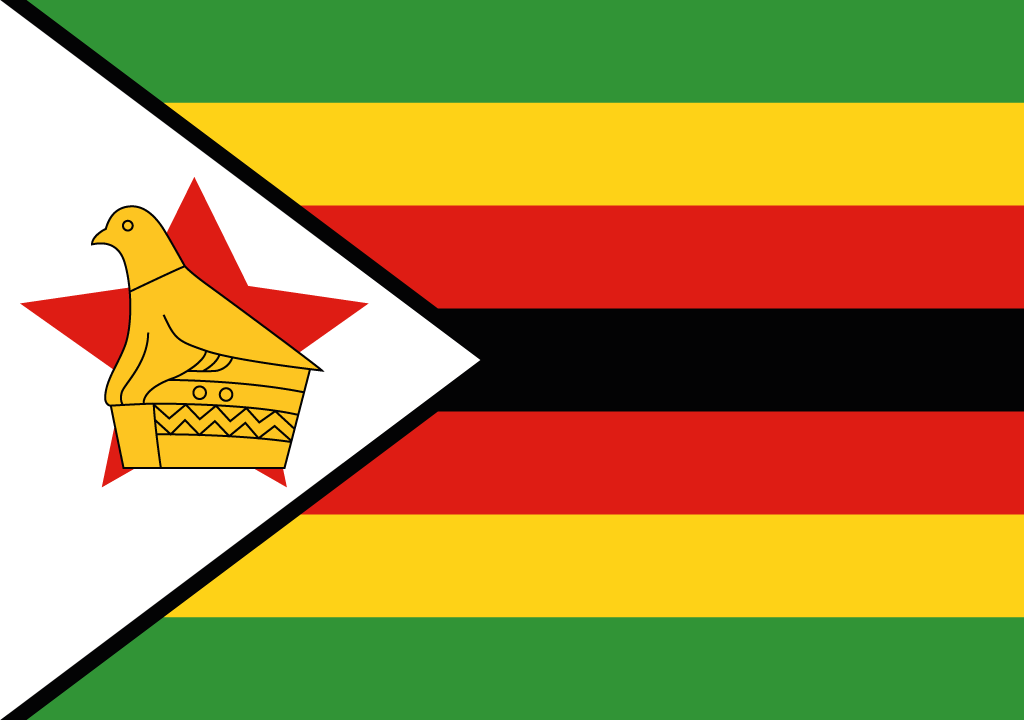
4 colors: green, yellow, red, black.
Meaning of the flag of Zimbabwe: The flag of Zimbabwe has the traditional pan-African colors. Green symbolizes the fertility of the fields and agriculture; yellow represents minerals, the rich natural resources of the country; red stands for the bloodshed during the war for independence; black symbolizes the native people of Zimbabwe and their legacy. The white on the triangle is for peace; the red star represents the rising hopes of the nation. The soapstone bird is a national symbol of Zimbabwe.
History of the Flag of Zimbabwe
Zimbabwe, formerly Rhodesia, has a flag with seven horizontal stripes with the following sequence of colors resembling a mirror: green, yellow, red, black, red, yellow, green (from top to bottom). The stripes are the same width.
There’s a white triangle on the left, with its base covering all the flag’s left side and the vertex pointing towards the center. In the middle of the triangle, there’s a symbol that includes a red five-point star and a yellow bird.
In addition to the obvious influence of the Pan-African movement, the choice of colors was also inspired by the ones used by the Zimbabwean African National Union – Patriotic Front political party, the leading builders of the current regime.
Black represents the African people, red represents the blood shed during the fight for independence, yellow represents the country’s mineral richness, and green represents its landscape. The white is associated with peace.
The red star officially represents the country’s aspirations to a better future but was most likely inspired by socialism and the revolutionary fight that allowed the current regime to rule. The bird represents the history of Zimbabwe.
This flag replaces the former Rhodesia one, that had three vertical stripes, white in the middle and green on the sides, with the coat of arms in the center. It was formally adopted on 18 April 1980.
States not recognized, partially recognized or disputed
Flag of Somaliland
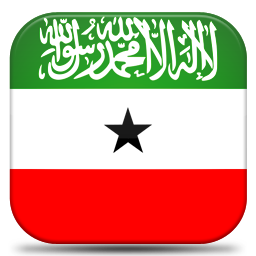
4 colors: green, white, red, black
Meaning of the flag of Somaliland: The flag uses Pan-Arab colors. Green represents the prosperity of the fields; white symbolizes peace and pure deeds; red is for the blood of the fallen heroes of the liberation. In the green background the Shahada is inscribed in white, the Islamic profession of faith “There is no god but Allah and Muhammad is his messenger”, which is the first of the Pillars of Islam. The black star represents the failure of the dream of Greater Somalia.


